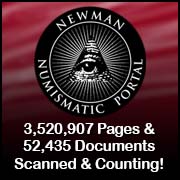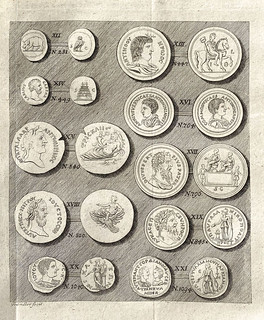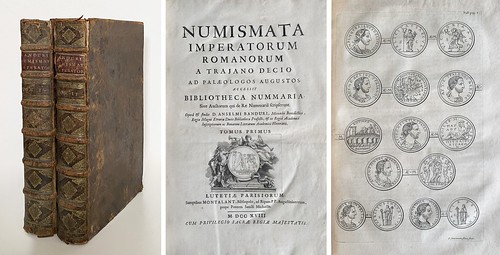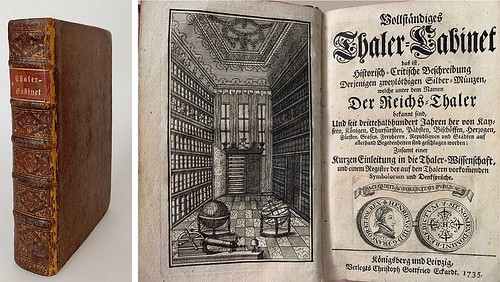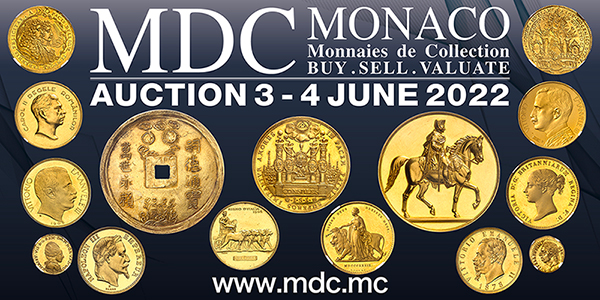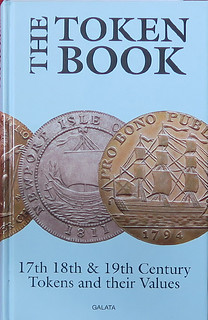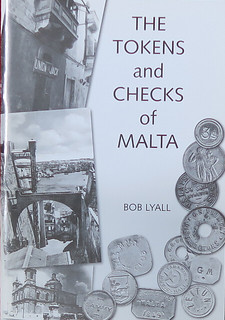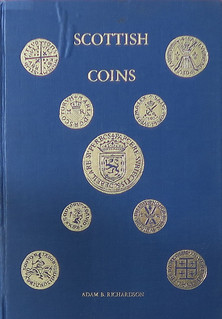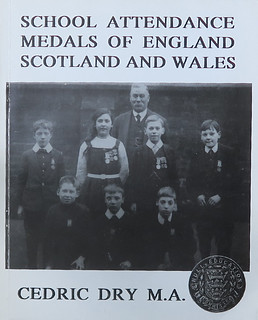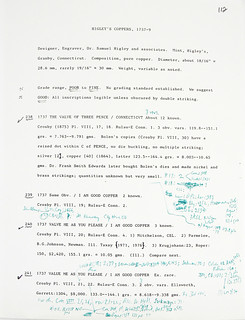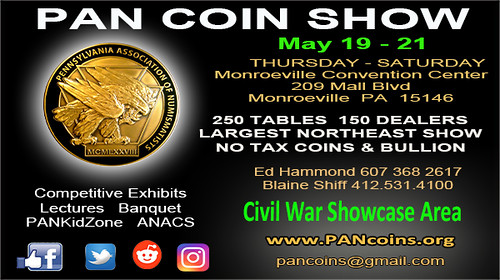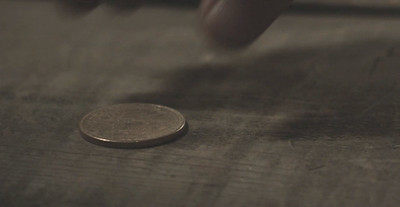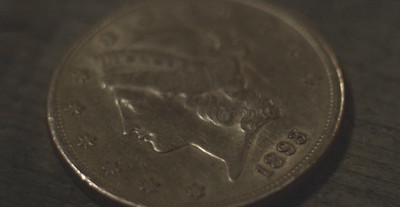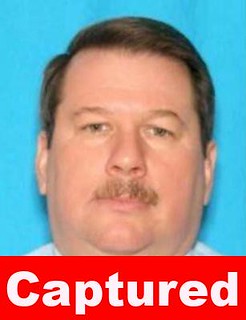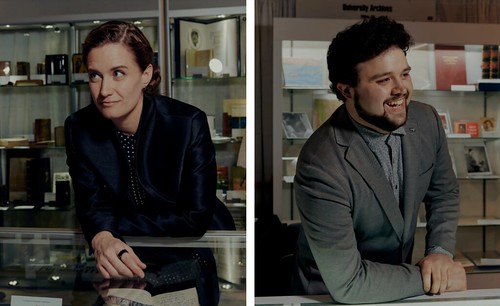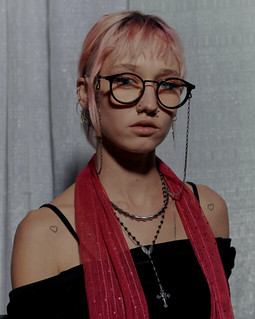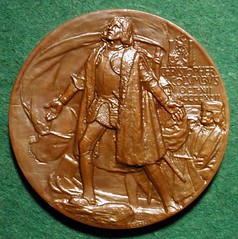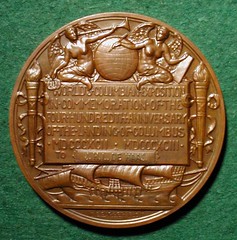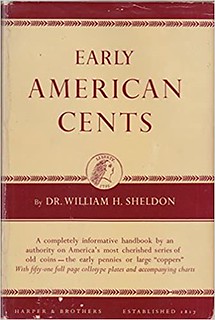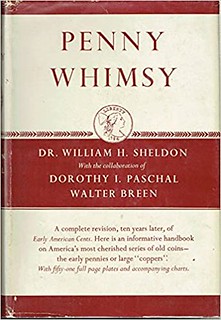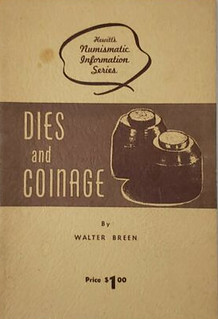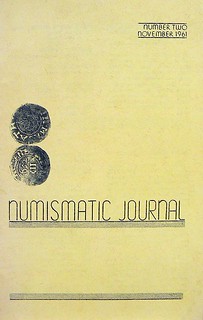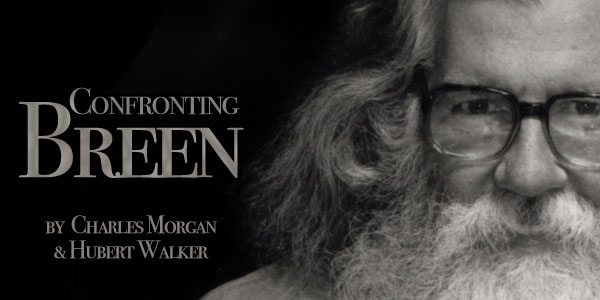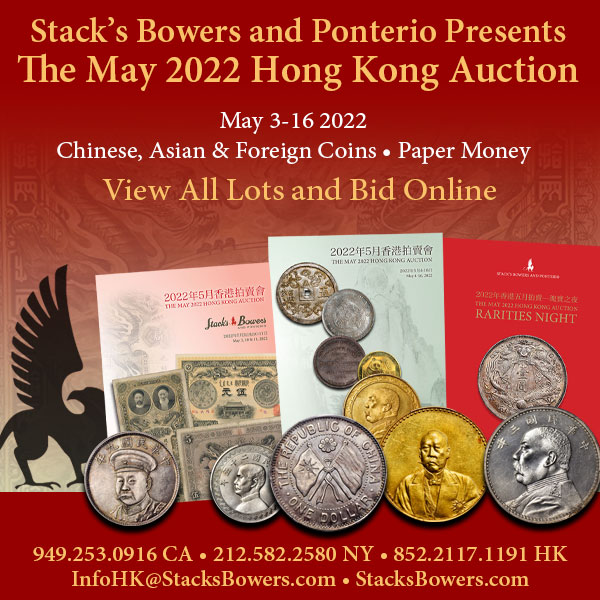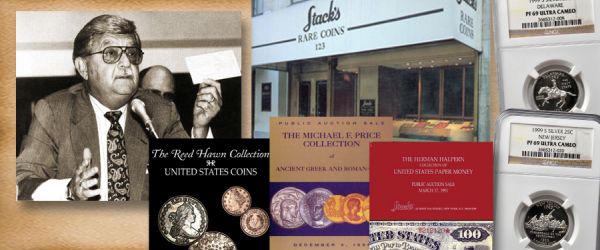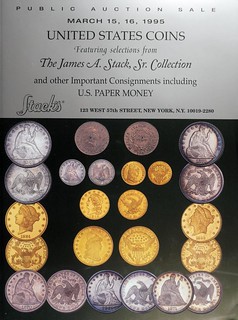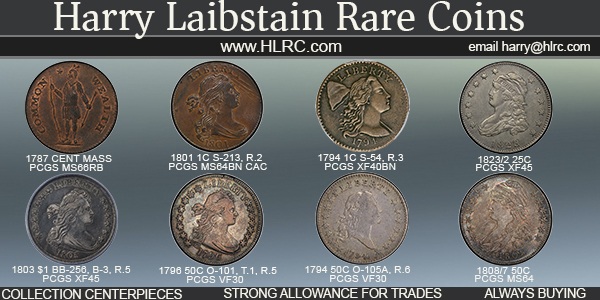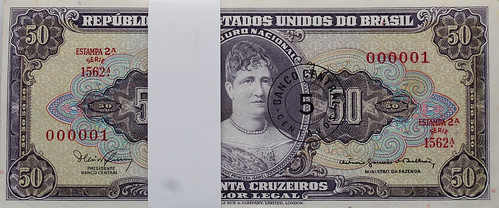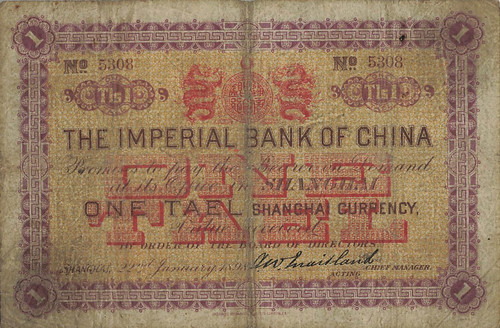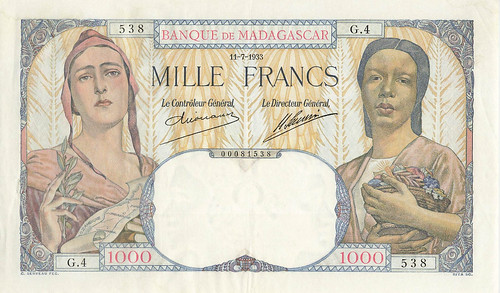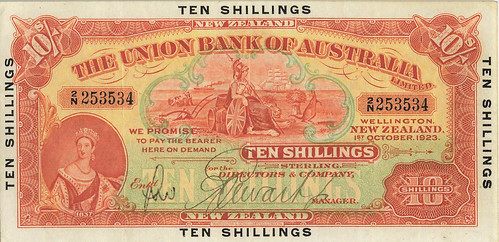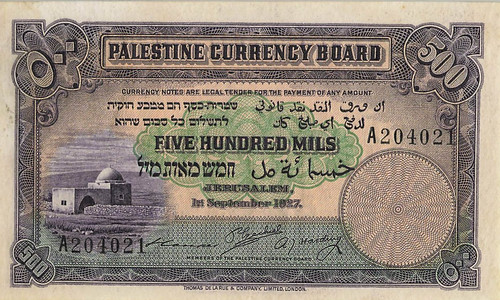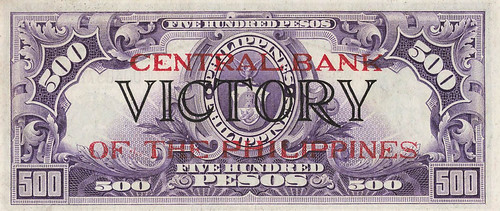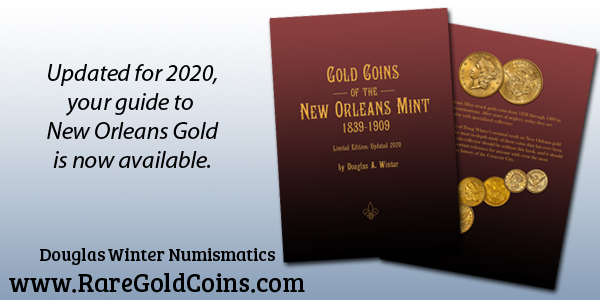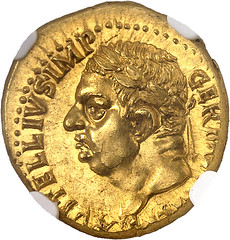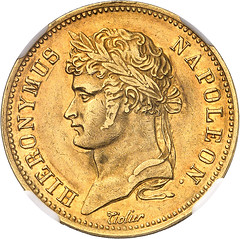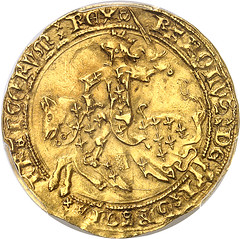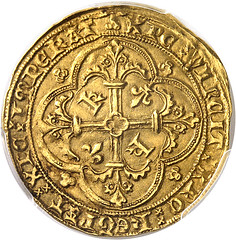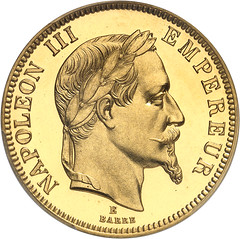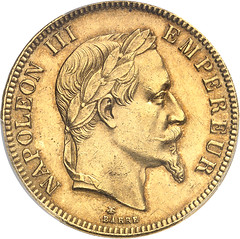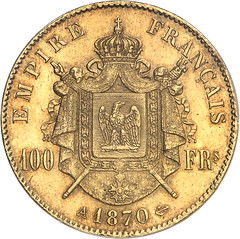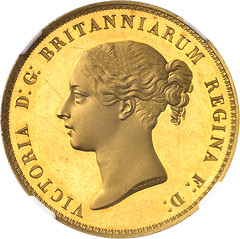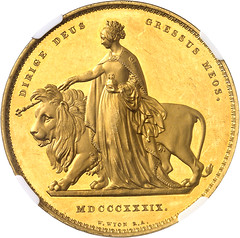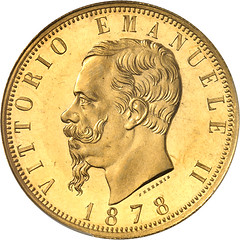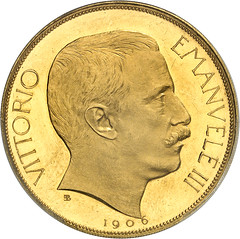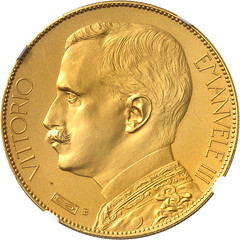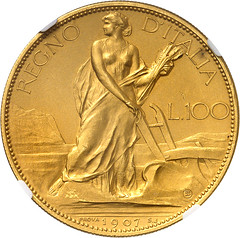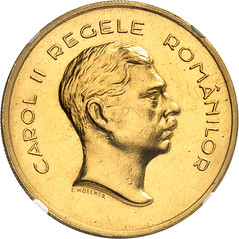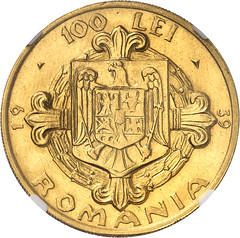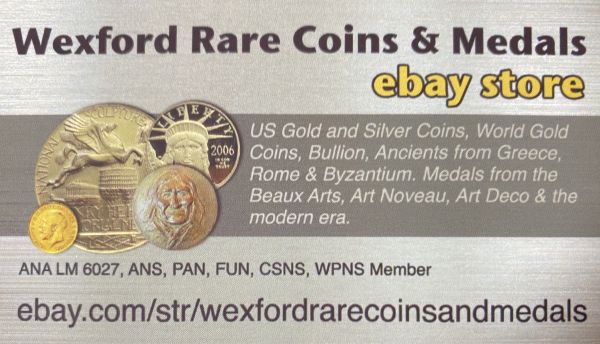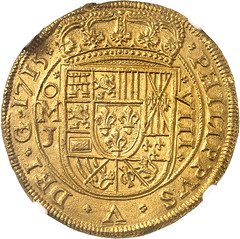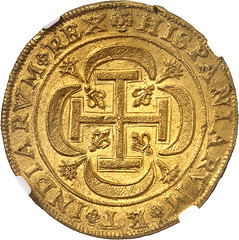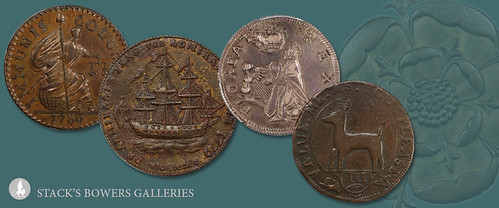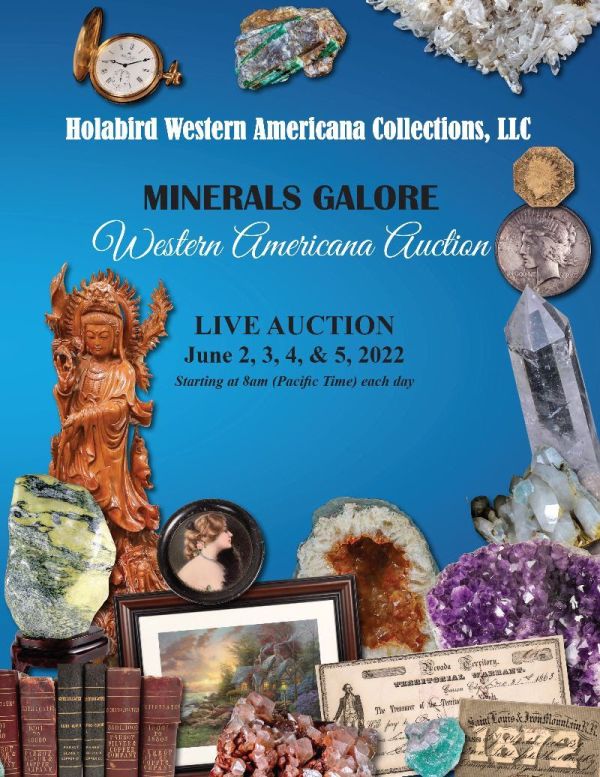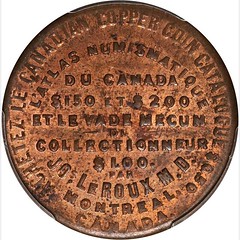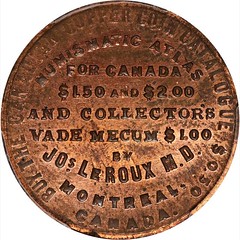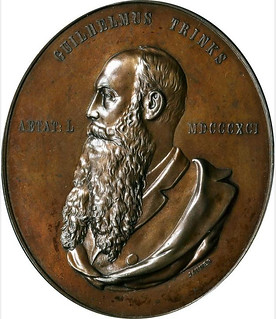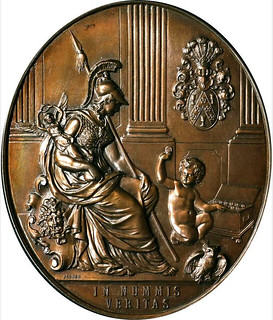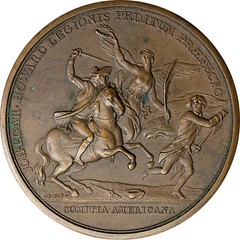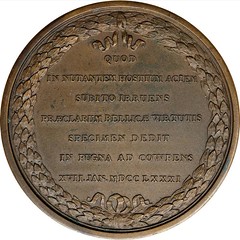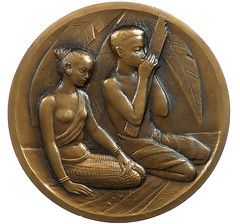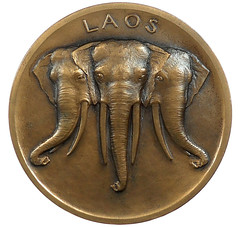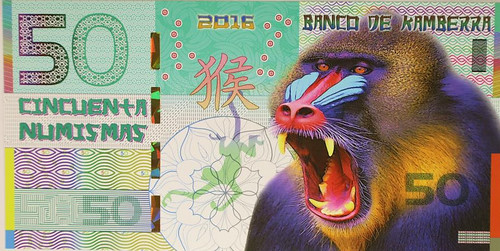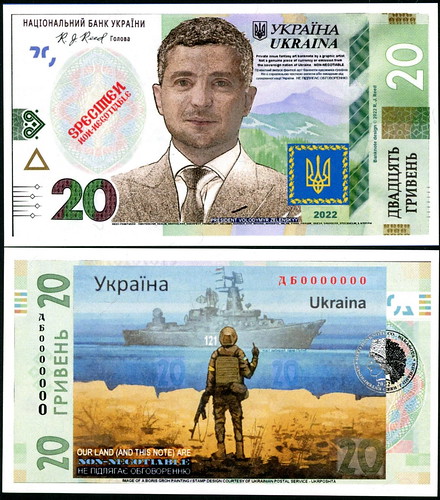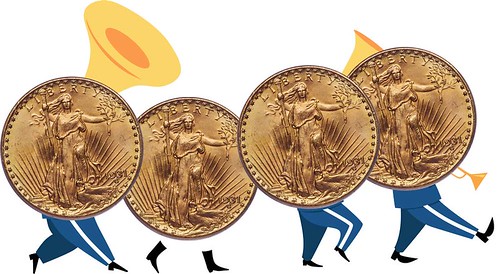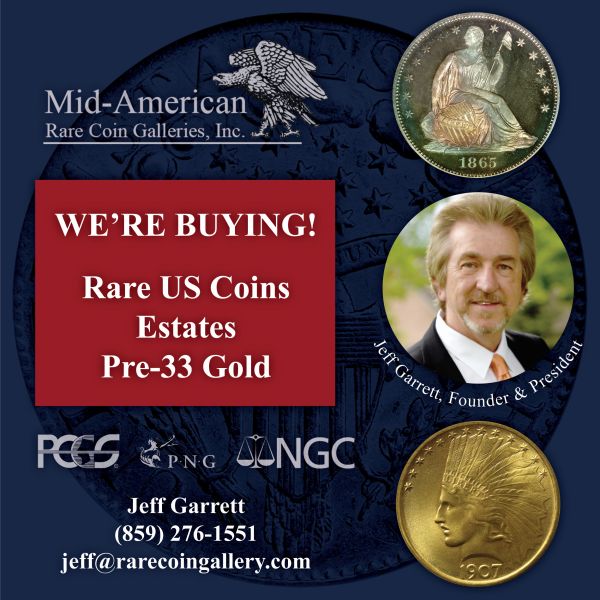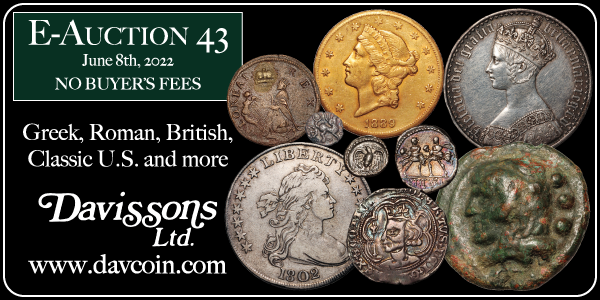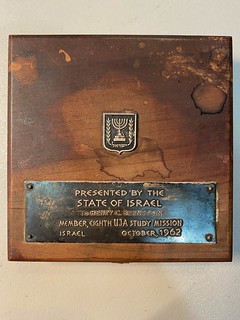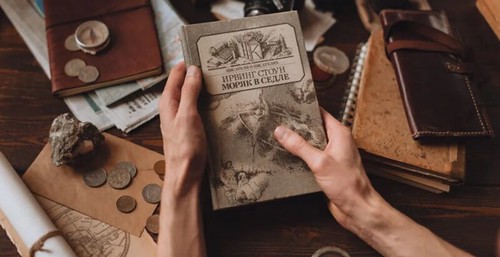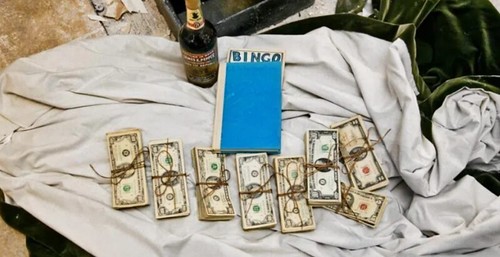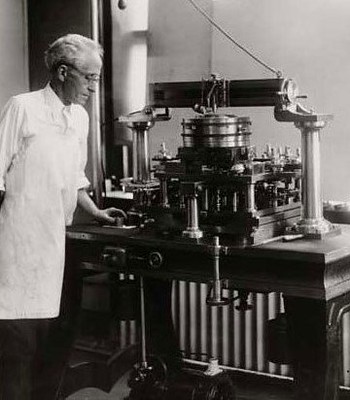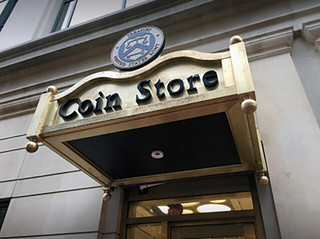
Visit our NBS Sponsors



About UsThe Numismatic Bibliomania Society is a non-profit association devoted to the study and enjoyment of numismatic literature. For more information please see our web site at coinbooks.org SubscriptionsThose wishing to become new E-Sylum subscribers (or wishing to Unsubscribe) can go to the following web page link MembershipThere is a membership application available on the web site Membership Application To join, print the application and return it with your check to the address printed on the application. Print/Digital membership is $40 to addresses in the U.S., and $60 elsewhere. A digital-only membership is available for $25. For those without web access, write to: Charles Heck, Treasurer AsylumFor Asylum mailing address changes and other membership questions, contact Chuck at this email address: treasurer@coinbooks.org SubmissionsTo submit items for publication in The E-Sylum, write to the Editor at this address: whomren@gmail.com BUY THE BOOK BEFORE THE COINSale CalendarWatch here for updates! |
- WAYNE'S WORDS: THE E-SYLUM MAY 20, 2022
- SOLIDUS 8TH NUMISMATIC LITERATURE SALE
- SIMMONS GALLERY MAY 2022 BOOK AUCTION
- MANLEY GIVES BREEN DOCUMENTS TO ANA LIBRARY
- NEWMAN PORTAL ADDS MUSICA IN NUMMIS
- VIDEO: COLLECTING ANCIENT COINS
- HELPING LOCAL COIN CLUB NEWSLETTER EDITORS
- NOTES FROM E-SYLUM READERS: MAY 20, 2022
- SIXBID NOW AVAILABLE IN EIGHT LANGUAGES
- A LIFE IN THE RARE BOOK TRADE
- A LIFE IN THE RARE COIN TRADE
- VOCABULARY TERM: INSERT DIE
- ROBERT BASHLOW, PART THREE
- HARVEY STACK'S NUMISMATIC FAMILY, PART 121
- MIKE CASTLE, COINAGE CONGRESSMAN
- WORLD BANKNOTE AUCTIONS SALE 26
- MDC MONACO JUNE 2022 AUCTION
- 1715 FLEET SPANISH PHILIPPE V ROYAL 8 ESCUDOS
- STACK'S BOWERS TO OFFER SYD MARTIN COLLECTION
- NUMISMATIC NUGGETS: MAY 20, 2022
- A CLASSIC AGRIGENTUM TETRADRACHM
- BETTER-DATE SAINT GAUDENS MARKET INTEREST
- MICHAEL ARMITAGE TO DESIGN NEW POUND COIN
- FAKE CANADIAN FAKE TWO-DOLLAR COINS SEIZED
- LEPROSY COINS
- ISRAEL PRESENTATION MEDALS
- FINDING AN OLD SAFE
- THE GEOMETRIC LATHE
- MAKING ART OUT OF INFLATION
- LOOSE CHANGE: MAY 20, 2022
- FEATURED WEB SITE: RNUMIS
Click here to read the thin version on the web
Click here to subscribe
Click here to access the complete archive
To comment or submit articles, reply to whomren@gmail.com
Content presented in The E-Sylum is not necessarily researched or independently fact-checked, and views expressed do not necessarily represent those of the Numismatic Bibliomania Society.
WAYNE'S WORDS: THE E-SYLUM MAY 20, 2022
 New subscribers this week include:
Terry Campbell, courtesy Allan Julius Behul;
Hondo Davids, courtesy O. T. Thompson;
Nathan Deinlein and Dalton Jenkins, courtesy Bill Rosenblum; and
Marie Gibbs.
Welcome aboard!
New subscribers this week include:
Terry Campbell, courtesy Allan Julius Behul;
Hondo Davids, courtesy O. T. Thompson;
Nathan Deinlein and Dalton Jenkins, courtesy Bill Rosenblum; and
Marie Gibbs.
Welcome aboard!
Thank you for reading The E-Sylum. If you enjoy it, please send me the email addresses of friends you think may enjoy it as well and I'll send them a subscription. Contact me at whomren@gmail.com anytime regarding your subscription, or questions, comments or suggestions about our content.
This week we open with two numismatic literature sales, donations to the ANA Library, updates from the Newman Numismatic Portal, and more.
Other topics this week include Musica in Numis, coin club newsletter editing, Sixbid, young people entering the rare book and coin trades, Mike Castle, auction previews, Saint Gaudens double eagles, a new pound coin design, fake toonies, and leprosy coins.
To learn more about the Schulz coin cabinet, wedding medals, insert dies, Robert Bashlow, Lynn Glaser, the Donald R. Shasky Collection of silver three-cent pieces, the "Royal" gold 8 escudos, the King Getas Octodrachm, the Year of the Monkey note, Israel presentation medals, the geometric lathe, and the U.S. Mint coin store, read on. Have a great week, everyone!
Wayne Homren
Editor, The E-Sylum
SOLIDUS 8TH NUMISMATIC LITERATURE SALE
The Munich firm Solidus is offering their 8th sale of numismatic literature on May 29, 2022. Here are some selected lots that caught my eye, with Google-translated descriptions. See the complete sale online. -Editor
 Literature Auction 99 (Rarities) - 29.05.2022 17:00
Literature Auction 99 (Rarities) - 29.05.2022 17:00
Selected numismatic literature with many rarities and bibliophilic treasures of the 17th and 18th century including parts of the library of a book-lover.
A pdf-file with all lot texts of the auction can be downloaded on the website of Solidus (menu auctions).
A link for viewing the illustrated print catalogue is available on the website of Solidus too (menu auctions).
Lot 1: The Twelve Caesars
Monographs. Bibliophile Works. Anonymous.
C. Suetonii Tranquilli XII Caesares et in eos Laevini Torrentii commentarius auctior et emendatior. Antwerp 1591. 407 p. with ill., index. Cardboard binding, bumped and scraped, partially stained and with signs of wear.
With library stamps.
Lot 7: Agnethler, The Schulz Coin Cabinet
Monographs. Bibliophile Works. Agnethler, M.G.
Description of the Schulz coin cabinet. Parts 1 - 4. Hall 1750 -1752. 7 sheets, 92 pages, 24+260 pages, 2 folders, 1 sheet, 164 pages, 1 sheet, 52 pages. Cardboard binding with spine labels, somewhat bumped, few annotations.
With library stamps.
Lot 11: Banduri, Numismata imperatorum Romanorum
Numismata imperatorum Romanorum a Trajano Decio ad Palaeologos Augustos accessit Bibliotheca Nummaria, sive auctorum qui de re Nummaria scripserunt. Paris 1718. 2 volumes. Frontispiece, 28 sheets, CXXVI, 1 sheet, 544 pages, 54 sheets; 8 sheets, 777 pages, 19 sheets, each with numerous illustrations. Full leather, bumped and scraped, capitals and joints damaged.
Lot 20: Cassel, Jubilee Wedding Medals
A collection of a number of jubilee wedding coins, struck on persons of distinguished families after fifty years of happily married life, and issued in memory of the families. Bremen 1759. 8 sheets, 94 pages, 6 pl. half linen.
Extremely rare.
Lot 32: Finauer, Bavarian Coins
Bavarian coin amusement, including showpieces, ducats, thalers and other remarkable gold and silver coins that are correctly depicted on the copper, described from history and explained. Munich 1768. 7 sheets, 190 pages, 9 pl. Half leather, slightly bumped.
With owner's note. Magnificent specimen.
Lot 55: Jobert, The Science of Medals or Coins
Introduction to the science of medals or coins, for the instruction of those who wish to acquire a thorough knowledge of both ancient and modern coins. Leipzig 1718. Frontispiece, 28, 488 p., register (24 p.), 11 folds. whole parchment.
Lot 92: Lilienthal, Complete Thaler Cabinet
Complete thaler cabinet that is, historical-critical description of those two-lot silver coins, which are known under the name of the imperial thaler, and for three and a half hundred years ago by emperors, kings, electors, popes, bishops, dukes, princes, counts, Free lords, republics and cities have been defeated on all kinds of occasions. Together with a short introduction to Thaler science and an index of the symbology and sayings found on the Thaler. Königsberg and Leipzig 1735. Title copper, 20, 450 pages, index. Full leather, slightly bumped and scraped.
To bid, see:
Literature Auction 99 (Rarities) - 29.05.2022 17:00
(https://solidus-numismatik.auex.de/Auktion/Onlinekatalog?intAuktionsId=1244)
To read the catalog online, see:
https://www.yumpu.com/de/document/read/66831816/a-99-mit-cover
SIMMONS GALLERY MAY 2022 BOOK AUCTION
Simmons Gallery in London is also holding a numismatic literature sale this month. Here are some selected lots. -Editor
The library of the late Scottish collector Andrew Macmillan is being auctioned by Simmons Gallery on Tuesday 17 May online only from 12 noon.
His interests were in all things Scottish, with a particular emphasis on church communion tokens. This library is probably the the best for such humble tokens and their historical background. Some items are annotated photocopies of the hardbacks also offered here, many rare or scarce to find. Start prices are low and everything has to go!
Lot 1: The Token Book 17th 18th & 19th Century Tokens and their Values, Paul & Bente Withers, 2010
Lot 11: Trade Tokens Issued in the 17th Century by George Williamson
Lot 13: Seventeenth Century Tradesmen's Tokens of Lincolnshire: The Issuers by T W Townsend
Lot 39: The Tokens and Checks of Malta by Bob Lyall 1999
Lot 60: British Countermarks on Copper & Bronze Coins, by J Gavin Scott
Lot 75: Catalogue of Scottish Coins in the National Museum Edinburgh by Adam Richardson 1977 reprint with priced insert
Lot 88: The Art and Craft of Coin Making by Denis R Cooper 1988, hardback
Lot 89: School Attendance Medals of England Scotland and Wales by Cedric Dry 1992, paperback
For more information, or to bid, see:
https://simmonsgallery.co.uk/category/auction/?mc_cid=db75b5c65f&mc_eid=9aa4c5d89a
MANLEY GIVES BREEN DOCUMENTS TO ANA LIBRARY
This press release highlights a new donation to the ANA Library by its benefactor and namesake Dwight Manley. -Editor
Receives Important Donation From Dwight N. Manley
Walter Breen's Documents Can Help Future Researchers
Prominent collector and benefactor Dwight N. Manley of Brea, California has donated to the American Numismatic Association more than 60 books, auction catalogs, and photographs he recently acquired at auction from the Sydney F. Martin (1945-2021) Numismatic Library Collection. All the items were previously owned or annotated by noted numismatic researcher and author Walter Breen (1928-1993) and many have his handwritten notes.
Among the highlights of the donation are two annotated drafts of Breen's massive 1987 masterpiece, Walter Breen's Complete Encyclopedia of U.S. and Colonial Coins, with thousands of handwritten notes made as he typically did in different color inks. The combined drafts total over 3,000 pages and were described by auction house Kolbe & Fanning Numismatic Booksellers as an exceptionally important part of the Breen archives.
Another annotated book is Breen's personal copy of the 1981 reference guide he co-authored with former ANA President Anthony Swiatek, The Encyclopedia of United States Silver & Gold Commemorative Coins, 1982-1954.
There are 29 auction catalogs each with Breen's handwritten notes. The sales dates range from a Stack's auction in 1951 to the Rarcoa offering of the Kaufman Collection in 1978.
The donation also includes several letters Breen wrote and 19 photographic plates depicting colonial-era state and other pre-federal coins with his handwritten notes on rarity. Among the plates are black and white prints depicting obverses and reverses of 1785 Connecticut coppers. These photos were produced by Al Hoch in the late 1960s and are the coins extensively cited in Breen's famous 1975 Early American Coppers organization sale catalog of Connecticut coppers.
Walter Breen had a troubled personal life, but he was one of the top numismatic researchers of his era. These important documents can help current and future researchers provide useful information for our hobby,
said Manley.
In 2003, the ANA Library at ANA headquarters in Colorado Springs, Colorado was named in honor of Manley when he gratefully donated $250,000 to the Association. That donation was a thank you
for the $400 scholarship he received as a teenager in 1980 to attend an ANA Summer Seminar session.
In 2007, Manley donated an original edition of the world's first illustrated numismatic book, Illustrium Imagines, published in 1517.
NEWMAN PORTAL ADDS MUSICA IN NUMMIS
The latest addition to the Newman Numismatic Portal is Musica in Nummis. Project Coordinator Len Augsburger provided the following report. -Editor
German Numismatic Musicians
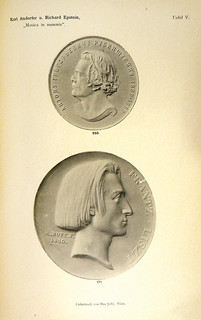 A Newman Portal user asked if we had the volume Musica in Nummis (1907) by Karl Andorfer and Richard Epstein. The answer was no, but we were able to locate it on a public domain site and add it to our collection. The work, in German, is a compilation of 984 medals with musical themes and includes 9 plates. The effort is obviously akin to Jay Galst's Ophthalmologia in Nummis and other numismatic works that specialize in a single (non-numismatic) subject.
A Newman Portal user asked if we had the volume Musica in Nummis (1907) by Karl Andorfer and Richard Epstein. The answer was no, but we were able to locate it on a public domain site and add it to our collection. The work, in German, is a compilation of 984 medals with musical themes and includes 9 plates. The effort is obviously akin to Jay Galst's Ophthalmologia in Nummis and other numismatic works that specialize in a single (non-numismatic) subject.
In cataloging this item, we learned that Paul Niggl acquired the collection that formed the basis for the 1907 work and expanded it over time. Niggl published an updated version of the catalog in 1965, entitled Musiker-Medaillen and now including 2,349 items. Niggl's collection was sold in a single lot by Spink and Son (July 14, 1998, lot 403), and appeared again, in multiple lots, in a November 2008 Baldwin sale.
We had to ask our favorite German-speaking numismatic musician if they were aware of this collection, and the answer was surprisingly no.
Image: Plate V from Musica in Nummis
Link to Musica in Nummis on Internet Archive:
https://archive.org/details/musicainnummis/page/n1/mode/2up?view=theater
VIDEO: COLLECTING ANCIENT COINS
These are selections from the David Lisot Video Library that feature news and personalities from the world of coin collecting. David has been attending coin conventions since 1972 and began videotaping in 1985. The Newman Numismatic Portal now lists all David's videos on their website at:
https://nnp.wustl.edu/library/multimediadetail/522852
Here's one with dealer David Rifkin on collecting ancient coins. -Editor
Coin Dealer Promotes Ancient Coin Collecting to Collectors and Kids.
VIDEO: 5:09.
 David Rifkin, Tiber Numismatics,
David Rifkin, Tiber Numismatics,
David Lisot, Interviewer, CoinTelevision.com.
April 1, 2022.
Everyone realizes that new coin collectors are needed to keep the hobby strong. Some dealers work harder than others to promote numismatics. Coin dealer David Rifkin enjoys sharing ancient coin collecting with other coin dealers, collectors and kids.
David adds:
"Ancient coin collecting can be a challenge for most people because they think it is too expensive and difficult to learn. This video will show this is not so!"
An excerpt of the video is available for viewing on the Coin Television YouTube Channel at:
https://youtu.be/Xi9yH1XvLaM
HELPING LOCAL COIN CLUB NEWSLETTER EDITORS
Paul Kluth edits the E-Gobrecht, an email newsletter for members of the Liberty Seated Collectors Club. In the May 2022 issue, he reported on a new effort to assist Editors of Local Coin Club Newsletters. With permission, we're republishing his notes here. Thanks, and good luck to all! Great project. -Editor
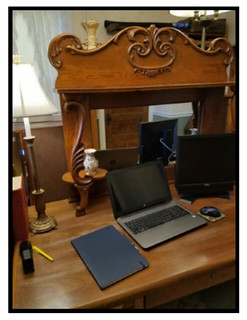 It has long been recognized that local coin
clubs across the country are generally focused
on growing interest in the numismatic hobby
within their communities, providing a social
activity for members and sharing knowledge
and experiences among colleagues besides the
typical buying, selling and trading of coins and
currency among members.
It has long been recognized that local coin
clubs across the country are generally focused
on growing interest in the numismatic hobby
within their communities, providing a social
activity for members and sharing knowledge
and experiences among colleagues besides the
typical buying, selling and trading of coins and
currency among members.
Three other areas of endeavor in particular always seem to be a top priority for most clubs whether they are small or large in membership size, regional in nature, or are of a specialty area focus (like Liberty Seated series collecting)
The #1 Priority always seems to be getting more members of the club engaged in actually helping out with administrative responsibilities on a consistent basis. Usually it is just a few members or officers who do most of the work for the club and not enough other members come forward to volunteer and help out. Also, too few members tend to provide the educational programs needed for others to enjoy.
The #2 Priority is of course attracting young people to the club as members. This priority is certainly the #1 for the numismatic hobby overall if the hobby is to endure well into the future. It is even a bigger priority than say fakes & counterfeits, overgrading & gradeflation, and coin doctoring.
The #3 Priority is the important need these days for local clubs to have a viable website and club newsletter for its members. At times, clubs struggle with finding a capable member with the time, desire and ability to create and manage their club website, and to find the same capable type of member to publish their club newsletter.
Like all these priorities, there are challenges! But putting together a club newsletter with fresh information and engaging articles each period, not to mention its design and layout can be a difficult task for the chosen volunteer given the responsibility.
There may be a general hobby support solution for club newsletter editors on the way...
Editors of Local Coin Club Newsletters
Presented by Paul Kluth, Phil Vitale and Greg Burns
For about a year now, there has been a small group of newsletter editors from various coin clubs across the country that have shared amongst ourselves our published monthly newsletters, and shared both ideas & tips for improving the product of our efforts for the benefit of club members and improving our own skill sets with the publishing tools at hand.
It is also a way to share news and educational articles relevant to our own clubs that might only get published locally, but worthy of a larger audience for those authors.
This all started because Phil Vitale, President of the Albuquerque (NM) Coin Club and
Editor of their monthly club newsletter Pocket Change
presented a class for the ANA Educational Forums on the serious topic of improving Club Newsletters. Pocket Change also won
Best Club Publication
from the ANA's Literary Awards before the pandemic.
Here's the big question: As a club newsletter editor, would you be interested in being a part of this group? We could have periodic Zoom Meeting conference calls with training, troubleshooting and great idea sharing on topics of importance to you with the goal of making your job as an editor a little easier.
In addition to myself and Phil Vitale, Greg Burns, Editor of the California Numismatist
for CSNA & NASC, Len Augsburger of the Newman Numismatic Portal and other club
editors are interested in supporting such a specialty group as organizers and mentors.
Organizing ideas are flying off the shelf!
NOTES FROM E-SYLUM READERS: MAY 20, 2022
More on the Stunning Restrike Continental Dollar Die Sale
Regarding the recent Heritage six-figure sale of the restrike Continental Dollar die from the Fred Weinberg collection, Fred writes:
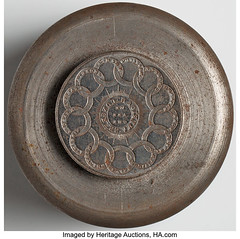 "I'm just as stunned as everyone else - I've been assured by Heritage that the winning bidder is a serious client of theirs, and I was also contacted by another dealer who has this winner as a good customer, and they just wanted to know any background about the die - which I could not provide.
"I'm just as stunned as everyone else - I've been assured by Heritage that the winning bidder is a serious client of theirs, and I was also contacted by another dealer who has this winner as a good customer, and they just wanted to know any background about the die - which I could not provide.
"I bought the die in the early '80's, I believe (not sure), and I cannot recall where or who I purchased it from - I had a variety of different ones I picked up over my 50 years as a dealer."
To read the earlier E-Sylum article, see:
CONTINENTAL DOLLAR RESTRIKE DIE SELLS BIG!
(https://www.coinbooks.org/v25/esylum_v25n19a11.html)
On Restrikes of the Dickeson Continental Dollar
Tom DeLorey writes:
"I would like to politely disagree with Pete Smith's comments about who struck the 7,200 White Metal restrikes of the (c. 1859) Dickeson 1776-dated Continental Dollar for the Empire Coin Co. c. 1961-62, but to do so I must also disagree with my younger self. In my June & July, 1980 article on Thomas Elder in the Numismatist I did say that Bashlow had struck the pieces for Empire, and Pete was just quoting me, but I was wrong.
"According to more recent email correspondence I have had with Q. David Bowers on the subject, most recently in 2017 (and reconfirmed this week), he said that he believed that Empire Coin Co. had gotten the dies from John J. Ford, and that he thought that the 7,200 White Metal strikes were made by John Pinches of London. Empire then sold the dies to Bashlow, who did what he did with them.
"Entirely on my own, I would speculate that if the original Dickeson dies did indeed come to Empire from Ford, and I have no reason to doubt that they did, that Ford got them from the estate of F.C.C. Boyd, which Ford purchased after Boyd died in 1958. Boyd was a close friend of Thomas L. Elder, and was mentioned on a few Elder medals.
"The ANA Museum had many Elder medals that I was told, when doing my research on Elder prior to the 1980 article, had been donated by Ford as ex-Boyd. I recall that there was one particular DeLorey number which my notes from the Elder auction catalogues said had 10 pieces struck in Red Fibre, of which the Museum had 7 of the 10!"
Thanks for the update! -Editor
To read the earlier E-Sylum article, see:
ROBERT BASHLOW, PART TWO
(https://www.coinbooks.org/v25/esylum_v25n19a16.html)
The "Mojave" 1893 Double Eagle
Brian Healy writes:
"The May 8, 2022 E-Sylum had a short article about the 2016 film "Mojave" which had an 1893 Double Eagle in it. I watched a little of the film and at about 80 minutes into the film the coin appears on a table twice. I have attached two screen prints of the coin."
Thanks! -Editor
To read the earlier E-Sylum article, see:
NOTES FROM E-SYLUM READERS: MAY 8, 2022 : Coins in Movies: Mojave
(https://www.coinbooks.org/v25/esylum_v25n19a12.html)
FBI Most Wanted, Supermodels, and Dismes
Pete Smith writes:
"The May 8 issue of The E-Sylum stated that Bernard Ross Hansen had been placed on the FBI Most Wanted List. I believe this is incorrect. I also believe the fault lies with the source article and not with The E-Sylum.
"One of my sources indicates that, at any one time, there are about 12,000 fugitives wanted by the FBI. I believe Hansen is one of those and not on any "Most Wanted" list.
"I once dated a local model. However, she was not a "Supermodel" so it was not a big deal. Perhaps the numismatic difference is like the difference between a dime and a disme."
That's right - the article we quoted used the term "Most Wanted". The FBI web site is easy to check and Hansen isn't on the Ten Most Wanted List, at least not anymore. According to the pages linked below Hansen and his travelling companion have been captured.
I remember reading an article about long odds - winning a PowerBall Jackpot, getting hit by lightning, dying in a plane crash, etc. All were pretty astronomical - 1 in many millions. Then I read that the chances of dating a supermodel were 1 in 40,000. So I'm thinking, hey - I got a shot! -Editor
For more information, see:
https://www.fbi.gov/wanted/wcc/bernard-ross-hansen
https://www.fbi.gov/wanted/wcc/diane-renee-erdmann
To read the earlier E-Sylum article, see:
FBI Seeks Former Northwest Territorial Mint Officials
(https://www.coinbooks.org/v25/esylum_v25n19a35.html)
More on the "Tender" Edge-engraved Cents
Responding to my question about whether anyone has seen the "Tender" edge-engraved cents in circulation,
B.J. Herbison writes:
"No, but a bunch have sold on eBay, many for $50. One sold Wednesday for $379, and there's one with an optimistic Buy It Now price of $809 because the edge is a little different."
Thanks! I'm not surprised these have found their way to eBay. That seems like a high price for a piece with 120,000 made, but Supply and Demand, baby. -Editor
To read the complete lot descriptions, see:
2020 p One Cent Coin Edge Engraved The Body Was Already So Fragile By Jill Magid
(https://www.ebay.com/itm/175267724928)
RARE!!!! 2020 D One Cent Coin Edge The Body Was Already So Fragile By Jill Magid
(https://www.ebay.com/itm/234015995485)
To read the earlier E-Sylum articles, see:
TENDER: AN EDGE-LETTERED CENT ART PROJECT
(https://www.coinbooks.org/v23/esylum_v23n40a24.html)
JILL MAGID'S TENDER PRESENCE FILM
(https://www.coinbooks.org/v25/esylum_v25n19a13.html)
SIXBID NOW AVAILABLE IN EIGHT LANGUAGES
I don't know how all the major U.S. auction sites handle localization, but this press release notes that the Sixbid platform is now available in six additional languages beyond the original German and English. -Editor
Sixbid Now Available in Six Additional Languages
Since 26 April 2022, Sixbid has also been available in Chinese, French, Italian, Japanese, Russian and Spanish.
Recent years have shown that the coin market is becoming increasingly international. Sixbid is reacting by adding further languages to its website. As of 26 April 2022, all features of Sixbid.com have been available in six new languages. Users are no longer limited
to bid on their favourite coin in German and English, they can now also bid in Chinese, French, Italian, Japanese, Russian and Spanish.
An International Platform – Right from the Beginning
When a group of coin dealers founded Sixbid in 2001, they had the international market in their mind from the very beginning. In 2001 that meant that, in addition to German, the features of the website were also available in English. With these two languages, Sixbid – the mother of all auction platforms – established itself as the standard auction platform for the German and the American market.
An International Market Requires Many Languages
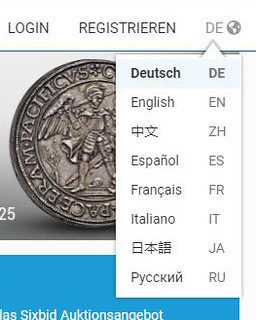 A market leader constantly has to adapt to changing circumstances. Sixbid meets this challenge by optimising its website regularly. Whereas many technical improvements and adjustments were highly important but hardly noticeable to most users, the new language options will please coin collectors across the globe.
A market leader constantly has to adapt to changing circumstances. Sixbid meets this challenge by optimising its website regularly. Whereas many technical improvements and adjustments were highly important but hardly noticeable to most users, the new language options will please coin collectors across the globe.
After all, especially the Asian market has become increasingly important over the past decades. These customers – and particularly those from China and Japan – play a key role in the auction business. For a long time, coin collectors from Asia were mainly purchasing coins of the highest price segment. By now, their interest has spread into all price segments and their participation has manifolded. Just like many Europeans, they are used to navigating the Internet using their own language. Sixbid has taken this into account and expanded its language options.
From now on, users can access almost all of Sixbid's features in eight languages. This means that Sixbid is available in Chinese, German, English, French, Italian, Japanese, Russian and Spanish. To activate your preferred language, you just have to choose it from the language options in the menu bar in the upper right corner of the website. If you then also select your favourite language in your account settings, you will receive all communication from Sixbid.com in the selected language.
More Than Auctions and Bidding
Sixbid has considerably expanded its range of services in recent years and now holds its own online auctions in collaboration with Auex. If you're registered with Sixbid, you no longer have to come up with new passwords all the time.
In addition, the Sixbid Collector's Archive provides hammer prices of hundreds of thousands of specimens free of charge, which you can use for your own research.
Give it a try! You can find the Sixbid website at www.sixbid.com
.
THE BOOK BAZARRE
A LIFE IN THE RARE BOOK TRADE
Mike Costanzo writes:
"The enormous multiplication of books in every branch of knowledge is one of the greatest evils of this age."
-Edgar Allen Poe, 1842
This quote is mentioned in The Last Bookseller, A Life in the Rare Book Trade by Gary Goodman (2021), and firmly cements my conclusion that Edgar Allen Poe would have never become a member of the NBS, much less a happy one. Aside from numismatic-related books, I occasionally indulge myself by reading of the joys and sorrows of book collecting and book-selling. Commonly referred to as "books about books," these tomes provide companionship, not to mention comfort, to those of us who enjoy spending quality time with a book, as well as those in the heated throes of assembling the perfect library. After years of serious book buying, it seems only natural to want to get into the lives (and heads) of those who supply us with our cherished reading matter.
Despite the brick and mortar bookshop becoming a vanishing breed, there are those who still forge ahead and go out on a financial limb to live the dream. While I make most of my book purchases on-line, there's still nothing like browsing in a bookstore. Accidents happen here, and you can stumble upon something you weren't looking for, much less even knew existed. As musician David Bowie once observed, "You always find the book you didn't know you wanted" at a book store.
Thanks. As a bibliophile in general (not just numismatic), I enjoy reading books like these about the trade. One meets a fascinating range of great people and "characters" who share the love of knowledge.
This week the New York Times published an encouraging article about the young people entering the book trade today. Here's an excerpt, but be sure to read the complete piece online. -Editor
Ms. Romney is an established seller known to Pawn Stars
fans as the show's rare books expert. But at 37, she represents a broad and growing cohort of young collectors who are coming to the trade from many walks of life; just across the aisle, Luke Pascal, a 30-year-old former restaurateur, was presiding over a case of letters by Abraham Lincoln and George Washington.
Michael F. Suarez, the director of the Rare Book School at the University of Virginia, said that these days, his students are skewing younger and less male than a decade ago, with nearly one-third attending on full scholarships.
The world of the archive is actually considered pretty hip,
he said.
Of course, most entry-level collectors can't plunk down hundreds of thousands of dollars for a first edition. But by frequenting estate sales and used bookstores, scouring eBay for hidden gems and learning how to spot value in all kinds of items, enthusiasts in their 20s and 30s have amassed collections that reflect their own tastes and interests.
Their work has been elevated by prizes from organizations and sellers such as Honey & Wax in Brooklyn, which recognize efforts to create the most ingenious, or thoughtful, or original collections,
as opposed to the most valuable, Professor Suarez said. As a result, they are helping to shape the next generation of a hobby, and a rarefied trade.
Several young attendees stood out among the business-attire-and-book-core crowd at the fair — in particular Laura Jaeger, a petite 22-year-old with a shock of pink hair. Her mother, Jennifer Jaeger, owns Ankh Antiquarian Books in Chadstone, Australia, which specializes in books about Ancient Egypt; Laura is in the process of becoming a partner in the business.
She plans to expand its collection to reflect her interests, she said, like metaphysics and photography. But I still know my Greek, Roman, Egyptian rare books really, really well,
she said. I've been able to value books for a few years now.
Kendall Spencer, 30, also hopes to leave his mark on the antiquarian book world. A Georgetown Law graduate who became enamored with rare books while researching Frederick Douglass, he is working as an apprentice at DeWolfe & Wood Rare Books while he prepares to take the Massachusetts bar exam.
If you walk around here, there's no one behind a booth that looks like me,
said Mr. Spencer, who is Black.
To read the complete article, see:
Meet the New Old Book Collectors
(https://www.nytimes.com/2022/05/07/style/rare-used-book-collectors.html)
A LIFE IN THE RARE COIN TRADE
As noted in other articles recently, there is also noticeable interest among young people for the rare coin trade, an encouraging sign for the future of the hobby and business (bless you, Witter Coin University). Patrick Heller wrote a piece on Numismatic News encouraging students to work at a coin dealership. Here's an excerpt - see the complete article online. -Editor
Over the decades, the company where I work has hired dozens of middle school, high school and college students. About half of them have gone on to entrepreneurial careers. Several have become coin dealers either at this company or elsewhere. Others have become a certified public accountant, attorney, international sales, bank loan officer, florist or jeweler. The percentage of student employees who have gone on to entrepreneurial careers is many times higher than the overall average.
Might I suggest that being able to work at a coin dealership could prove more beneficial in the future to students than jobs where you might feel like you are only part of an assembly line.
Most businesses generate revenues in only one direction. To work at a coin dealership, an employee needs to have greater mental agility. Depending on the specific company, an employee might be called upon to either buy or sell, to work with retail or wholesale customers, in an environment where the inventory needs or cash flow requirements of the business are constantly changing, and where precious metals products can often experience 20,000 price changes during a day.
There are many lifelong coin dealers who first worked in the industry while they were students. If they become numismatists at a young age, the knowledge they accumulate may give them a jump-start toward an advanced rather than an entry-level position at a coin dealership.
 As a hobbyist, I've never worked in the coin business directly, but of course now I find myself in the numismatic publishing business with this newsletter. I could never interest our children in collecting, but I'm delighted that all three found jobs with Wizard Coin Supply, my friend Wayne Herndon's nearby business. None have gone the typical fast food server route, instead getting a front-row seat at a thriving small family business.
As a hobbyist, I've never worked in the coin business directly, but of course now I find myself in the numismatic publishing business with this newsletter. I could never interest our children in collecting, but I'm delighted that all three found jobs with Wizard Coin Supply, my friend Wayne Herndon's nearby business. None have gone the typical fast food server route, instead getting a front-row seat at a thriving small family business.
Our oldest son has been there the longest, moving from counting and packing coin supplies, to photographing stock and updating the database, to setting up and taking down coin shows, to expanding and stocking the warehouse, to packing and shipping orders (including valuable wholesale coin deals), and helping to manage the staff and locking up at the end of the day. He's gained experience in every aspect of e-commerce and logistics. You don't get that in most student jobs. So I second Patrick's recommendation - working in the coin business is a great way to start a career, whether you stay in the business or not - the experience is invaluable and could prove foundational for whatever career you choose. -Editor
To read the complete article, see:
Students Should Consider Coin Dealer Employment
(https://www.numismaticnews.net/coin-market/students-should-consider-coin-dealer-employment)
See also:
First Coin University program to be held in July in San Francisco
(https://www.coinworld.com/news/us-coins/first-coin-university-program-to-be-held-in-july-in-san-francisco)
Witter Coin U Grads
Talk Coins, Collecting & Camaraderie
(https://www.pcgs.com/news/witter-coin-u-grads-talk-coins)
To read the earlier E-Sylum articles, see:
COIN DEALER MATTHEW TAVORY
(https://www.coinbooks.org/v25/esylum_v25n14a30.html)
COIN COLLECTING BUSINESS ON SOCIAL MEDIA
(https://www.coinbooks.org/v25/esylum_v25n19a14.html)
VOCABULARY TERM: INSERT DIE
Here's another entry from Dick Johnson's Encyclopedia of Coin and Medal Terminology. I've added images from an earlier E-Sylum article of a medal found on Ben Weiss' Historical Art Medals site. Thanks again! -Editor
Insert Die. A special die and its supplemental part – an insert – employed to produce raised lettering on a medal. The die to contain the insert is machined with a cavity by a tool and diemaker. The cavity is somewhat boat shaped with bevel sides. The insert blank is made of steel, also by a tool and diemaker it is shaped to fit the cavity in the insert die The insert blank is then engraved incuse by a hand or machine engraving to contain the desired lettering. During striking the insert lies loose in the base die – only one side of a medal may have an insert and this die must be in the lower position in the press (it would fall out of the die in the upper position). Raised lettering is produced by this method, but always a tiny raised ridge outlining the insert appears as flash on a piece so struck; this line is diagnostic of the use of an insert. It may be removed by chasing on the struck piece if considered too obvious and unwanted.
A small or large quantity of medals with raised lettering can be made efficiently by the use of inserts from one setup of the press. Each insert must be engraved separately with the recipient's name and placed by hand in the insert die before striking. The award medals of the Columbian Exposition, for example, were struck by insert dies.
The first use of insert dies in America occurred during the Civil War. Numismatist Q. David Bowers found this technology was employed by Boston diesinker Joseph Merriam in 1863. From 1870s to 1920s billiard supply manufacturers provided tokens to their clients with their name (and sometimes the denomination) struck by insert die on the reverse. The tokens bore the advertisement of the billiard company on the obverse. Over two dozen such firms made tokens for use by billiard parlors, the tokens often bore an illustration of a pool table.
Any piece struck by an insert die without its insert would contain a large shapeless raised lump resulting from the cavity. On the opposite side would be a depression or ghosting effect as metal in the blank is drawn toward the cavity. See dies and diemaking.
Columbian Exposition Award Medals Made with Insert Dies
The most famous use of insert dies was for the Columbian Exposition Award Medal with obverse by Augustus St-Gaudens and reverse by Charles Barber (Eglit 19 and 90). These were ordered made at the U.S. Mint. But Columbian Exposition officials insisted the recipient's name be in raised lettering within the cartouche in the lower part of the panel on the reverse. The Mint made the dies but quickly realized they could not produce the quantity of such medals desired by fair officials.
So the Philadelphia Mint subcontracted the job of manufacturing these medals to Scovill Manufacturing Company of Waterbury Connecticut. It was not an easy job. I suspect Scovill demanded hubs from the Mint or made their own hubs once they got the dies on hand. (This is the cheapest form of insurance for such a long run of medals – something is bound to happen to a die in such case – it is easy to make new working dies from hubs on hand.)
First a cavity had to be made in the reverse die. This was done by a tool and diemaker. Then a large quantity of insert blanks had to be made the exact size and shape of that insert cavity. I suspect Scovill die struck these because of the large number needed. The insert blank must fit snugly into that cavity.
The insert blanks would then be heat treated to the proper hardness for engraving. Then each separate name would be engraved with the proper letters of the recipient's name. Not only were these medals awarded to individuals, but also firms, organizations – both private and governmental – even countries!
It probably required two or three engravers full time to keep ahead of the pressmen. A crew of at least four people – two engravers, a pressman, and a clerk – were required to produce the medals. Each name had to be engraved on the insert blank, a clerk had to check the accuracy of the lettering and record this in a journal. The approved insert would then be passed off to the pressman who would remove the previous insert and position the next insert into the die, then strike the medal.
At least one press was dedicated to this one job alone. All told, it took Scovill eighteen months to complete the striking. The order was for 23,000 medals! It is little wonder some recipients did not receive their medals until nearly two years after the fair was over.
Amazingly, one of the two journals with recipients' names, still exists in the Scovill Company archives at the Baker Library at Harvard University, Boston. The oversize journal contains the manuscript entries of names.
To read the complete entry on the Newman Numismatic Portal, see:
Insert Die
(https://nnp.wustl.edu/library/dictionarydetail/516154)
To read the earlier E-Sylum article, see:
ANSWER: 1893 COLUMBIAN EXHIBITION MEDAL WINNERS
(https://www.coinbooks.org/v21/esylum_v21n02a10.html)
ROBERT BASHLOW, PART THREE
American Numismatic Biographies author Pete Smith submitted the third of his articles on Robert Bashlow, known in numismatics for, among other things, creating satirical medals and restrikes of the Confederate cent. Thanks. WARNING - there is some disturbing content here. -Editor
In the third installment, I will discuss Robert Bashlow and Walter Breen. Walter Breen was working with Dr. William H. Sheldon at Columbia University in the 1950's. One result was the 1958 publication of Penny Whimsy, the revision of Sheldon's 1949 book, Early American Cents, the work that gave us all the 70 point grading system.
Columbia Medical School had a program for talented youth around 1953 to 1956 now known as the Columbia superkids project. Breen was coordinator of parapsychological research studies for the superkids who included Robert Bashlow.
To be included, he must have tested at the genius level. However, in my research I never found evidence that he had any post-secondary education. He went into the coin business at a young age, probably before he was twenty.
Several years ago, I was doing research on Walter Breen and came across the name of Bashlow in the 1998 trial deposition of Breen's wife, Marion Zimmer Bradley. She was involved in a civil suit brought by one of Walter's abuse victims.
Q. Did Walter ever tell you that he thought it was a mutually desired situation between [Victim
X] and himself?
A. I had read that in his book.
Q. Which book?
A. He wrote a book called Greek Love
under the name of John Eglington.
Q. And you reviewed some of the manuscripts of that book before it was published?
A. Yes, I did.
Q. And did you contribute by doing proofreading?
A. I did proofreading, yes.
Q. Did you do some editorial work on that book?
A. I attempted to, but I found out afterward that everything I had done had been thrown out by
the publisher, Robert Bashno (phonetic).
Later questions related to Bashlow and David Bradley. David Robert Bradley (11/18/1950 – 9/11/2008) was the son of Marion with her first husband, Robert Alden Bradley. David would have been 13 in 1964.
Q. The question is: Did you undertake any action to prevent any further contact between Robert
Bashlow and your then 13-year-old son after you learned that Mr. Bashlow had sexually
propositioned your son?
A. Well, I would say that -- that that was much more David's business than anyone else.
Q. So you didn't do anything to prevent Mr. Bashlow, did you, from coming in contact with your
son?
A. No, I did not.
Bashlow's association with QWERTYUIOPress is somewhat unclear. It is also affiliated with Ted White [Theodore Edward White or TEW]. In 1961, Bashlow's QWERTUIOPress was the printer for The Numismatic Journal, published by Lynn Glaser and edited by Walter Breen. At the time, Breen was about 31, Bashlow was 22 and Glaser was 18.
Bashlow and QWERTYUIOPress published Walter Breen's Dies and Coinage in 1962. This was reprinted by Hewitt in 1965.
Walter Breen wrote Greek Love under the pseudonym of J. Z. Eglinton. This was published by Oliver Layton Press in 1964. Ownership of the firm is subject of some speculation. One possibility is that Robert Bashlow owned the company or at least funded the publication.
In 1967, Bashlow was co-author with Tuli Kupferberg of 1001 Ways to Beat the Draft. This was the third and last title published by Oliver Layton Press.
Next week, the death of Bashlow.
In my zeal to collect all of Breen's works, I once owned a copy of Greek Love. I couldn't bring myself to read it and eventually got rid of it somehow. I don't miss it. For more background on Breen and pederasty, see the great CoinWeek article we excerpted in 2015. -Editor
To read the complete CoinWeek article, see:
CONFRONTING THE LEGACY OF WALTER BREEN
(https://coinweek.com/editors-choice/confronting-breen/)
To read the earlier E-Sylum articles, see:
CONFRONTING THE LEGACY OF WALTER BREEN
(https://www.coinbooks.org/esylum_v18n45a11.html)
ROBERT BASHLOW, PART ONE
(https://www.coinbooks.org/v25/esylum_v25n18a15.html)
ROBERT BASHLOW, PART TWO
(https://www.coinbooks.org/v25/esylum_v25n19a16.html)
HARVEY STACK'S NUMISMATIC FAMILY, PART 121
Stack's Bowers has a backlog of the late Harvey Stack's numismatic memoir articles and will continue publishing them. In this one Harvey discusses auction sales of 1995. -Editor
On the auction front, 1995 was a very important and active year for Stack's as we cataloged and presented nine separate auctions. These sales contained large and important collections of United States coins from colonials to modern issues as well as coins of the ancient world and foreign issues.
We started off the year in January with an offering of 1,725 lots of U.S. gold, silver and copper, with many early pieces in Mint State and Proof condition. Our March sale offered more items from the renowned James A. Stack, Sr. Collection plus other important consignments, including the The New Island Collection of U.S. Paper Currency. This offering from the Stack Collection was primarily duplicates from half cents to $20 gold and provided collectors with an opportunity to acquire more common dates and series from with this famous pedigree.
In May we had two catalogs. The first contained the Chesapeake Collection of U.S. gold, silver and copper coins, the Donald R. Shasky Collection of silver three-cent pieces, the Edward Milas Collection of No Motto half eagles in some of the finest grades known, and the Jac and Cornelia Weller Collection of Gold Coins. Our second May catalog featured Ancient and Foreign coins from the John Dresser Collection, the James A. Stack, Sr. Collection, and other important consignments. June brought an auction of over 1,200 lots that included the Dr. James A. Vander Zanden Collection which was sold on behalf of Yale University – what a wonderful gift to that institution. To start the fall season, in September we had a large sale of over 2,300 lots that was made up of consignments of United States coins and paper money from the John D. Sayer Collection, as well as cabinets formed by other prominent collectors. It was a wonderful sale featuring early, classic, and scarce numismatic items.
 In October 1995 Stack's celebrated six decades in the coin auction business with our appropriately named 60th Anniversary Sale. Over those years we had conducted hundreds of sales and presented many of the most famous collections to come on the market. The early auctioneer was my uncle, Joseph B. Stack, assisted by my father, Morton. In the early 1950s I started my time with the company, along with my cousins Benjamin and Norman. We continued to be among the foremost coin auctioneers in America, if not the world.
In October 1995 Stack's celebrated six decades in the coin auction business with our appropriately named 60th Anniversary Sale. Over those years we had conducted hundreds of sales and presented many of the most famous collections to come on the market. The early auctioneer was my uncle, Joseph B. Stack, assisted by my father, Morton. In the early 1950s I started my time with the company, along with my cousins Benjamin and Norman. We continued to be among the foremost coin auctioneers in America, if not the world.
For this important anniversary sale we presented the fabulous collection formed by Seymour Finklestein, a prominent New York City numismatist who had engaged Stack's to help build his impressive U.S. coin collection. Mr. Finkelstein started with a fine type collection. He then expanded into collecting Indian Head cents, two- and three-cent pieces, 20-cent pieces, trade dollars, 20th century gold, and other series, as well as silver and gold commemoratives. He had been an active client for years, purchasing both over the counter and in our auctions. The sale featured nearly 1,900 lots with many important items, including a choice offering of Saint-Gaudens double eagles and early Proof coins with some original sets. The opportunity to sell his collection in this landmark sale was a very nice gesture of thanks to Stack's for our help over the years. After his very successful sale, Seymour Finklestein pursued colonial American coins and historical medals.
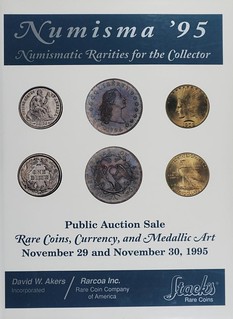 November 1995 brought about a reunion of sorts, as we participated in the "Numisma '95" sale that brought back together the firms of Stack's, Paramount, Rarcoa, and Superior. These auction companies had produced the "Apostrophe" sales from 1979 through 1990, quality auctions that featured 500 lots from each auctioneer. In 1995 Stack's was approached by Rarcoa and David Akers to consider another "joint sale" and we agreed. The sale offered a renowned collection of U.S. dimes, virtually complete in the choicest examples, both Proof and Mint State, from 1796 to the late 1940s. The highlight of the sale was the "Finest Known" 1794 silver dollar from the Leland Rogers type set of copper and silver coins. Also featured was the David Queller Collection of Saint-Gaudens $20 coins, a superb run of original Proof sets from 1880 to 1900, plus hundreds of early type coins from the late 18th through the 19th century. This joint sale attracted hundreds of collectors in person and a record number of bid sheets for the 2,000 lots.
November 1995 brought about a reunion of sorts, as we participated in the "Numisma '95" sale that brought back together the firms of Stack's, Paramount, Rarcoa, and Superior. These auction companies had produced the "Apostrophe" sales from 1979 through 1990, quality auctions that featured 500 lots from each auctioneer. In 1995 Stack's was approached by Rarcoa and David Akers to consider another "joint sale" and we agreed. The sale offered a renowned collection of U.S. dimes, virtually complete in the choicest examples, both Proof and Mint State, from 1796 to the late 1940s. The highlight of the sale was the "Finest Known" 1794 silver dollar from the Leland Rogers type set of copper and silver coins. Also featured was the David Queller Collection of Saint-Gaudens $20 coins, a superb run of original Proof sets from 1880 to 1900, plus hundreds of early type coins from the late 18th through the 19th century. This joint sale attracted hundreds of collectors in person and a record number of bid sheets for the 2,000 lots.
Closing out the important year of 1995 was our December sale of ancient and foreign coins, nearly 2,000 lots offered during a Fall Metropolitan New York Show. The sale offered choice and rare gold and silver coins of the ancient world, and a fine selection of world coins that included multiple Ducats in gold, large thalers, outstanding coins of the Orient, a superb collection of Medieval and early Renaissance coinage, and 18th to 20th century coins of the entire world. Collectors and dealers traveled from all over the world, as well as the United States to participate in this outstanding sale. 1960 had truly been a year to remember!
To read the complete article, see:
Growing up in a Numismatic Family: Part 121
(https://www.stacksbowers.com/News/Pages/Blogs.aspx?ArticleID=harvey-stack-remembers-121)
To read the earlier E-Sylum article, see:
HARVEY STACK'S NUMISMATIC FAMILY, PART 120
(https://www.coinbooks.org/v25/esylum_v25n18a16.html)
MIKE CASTLE, COINAGE CONGRESSMAN
I've long known of Congressman Mike Castle's role in coinage legislation. Recently NGC rolled out new certification labels featuring his signature, and the announcement has a nice overview of his contributions to the hobby. Here's an excerpt - see the complete article online. -Editor
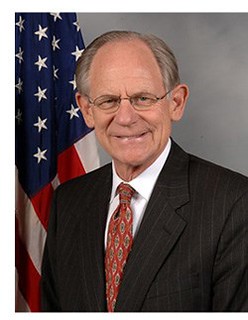 Castle was Delaware's at-large representative in the House from 1993 to 2011, after serving two terms as governor. While in Congress, Castle wrote and/or sponsored the bills that created the 50 State Quarters® program, the Sacagawea Dollar, the Presidential Dollar Series, the American Platinum Eagle, the America the Beautiful Quarters® program and a number of modern commemoratives — becoming known as
Castle was Delaware's at-large representative in the House from 1993 to 2011, after serving two terms as governor. While in Congress, Castle wrote and/or sponsored the bills that created the 50 State Quarters® program, the Sacagawea Dollar, the Presidential Dollar Series, the American Platinum Eagle, the America the Beautiful Quarters® program and a number of modern commemoratives — becoming known as The Coinage Congressman.
It is estimated that 150 million Americans — half of the country's population at the time — became casual coin collectors because of 50 State Quarters program, which raised nearly $7 billion in profit for the federal government. Many would become more serious modern coin collectors, which had a transformative effect on the hobby and propelled modern coin collecting into the juggernaut that it is today.
The State Quarters series started in 1999 with Delaware, the first state admitted into the Union and Castle's home state. By the time the Delaware Quarter was released, however, Castle had already begun to leave his mark on US coinage.
The first numismatic legislation that Castle sponsored was the Commemorative Coin Authorization and Reform Act of 1995, which created the American Platinum Eagle bullion coin.
A year later, Castle drafted the legislation that limited the number of new commemorative coin subjects to two per year. This limit, designed to focus the series and build collector interest, continues to shape the modern US commemorative coin series. He also drafted and sponsored the legislation for several new commemoratives, including the 2006 silver dollars that honored Benjamin Franklin, an ancestor of Castle's.
In his last piece of numismatic legislation, Castle created the America the Beautiful Quarters program to begin after the conclusion of the State Quarters program. Significantly, this act called for the creation of a five-ounce silver bullion coin, the largest silver coin ever created by the US Mint.
To read the complete article, see:
NGC Honors 'Coinage Congressman' Mike Castle with New Congressional Series Label
(https://www.ngccoin.com/news/article/10097/)
For more information, see:
Mike Castle
(https://en.wikipedia.org/wiki/Mike_Castle)
Legislation Sponsored or Cosponsored by Michael N. Castle
(https://www.congress.gov/member/michael-castle/C000243)
WORLD BANKNOTE AUCTIONS SALE 26
Here's the press release for World Banknote Auctions upcoming Live Sale 26. More great notes! -Editor
World Banknote Auctions has now listed Live Sale 26 on its website, which closes in two different segments. The first segment, the traditional live sale, closes on May 26th, 2022, with live bidding that day at 1 PM Eastern / 10 AM Pacific. The following day, on May 27th at 1 PM Eastern / 10 AM Pacific an additional segment closes in a timed auction (no live bidding, although lots may be extended if a bid is received 10 minutes before closing). Live Sale 25 offers a total of 936 lots from around the world, with highlights including a strong middle eastern selection, including the key note for Qatar & Dubai, as well as a strong selection of other items for both the beginning and advanced collector. Some highlights are selected below but the entire catalog can be viewed on the company's website, www.worldbanknoteauctions.com
Lot 26007 is an extremely rare note from the Angola branch of the Banco Nacional Ultramarino, the main bank for the Portuguese colonies throughout most of its history. This particular example, Pick-25, is graded Extremely Fine 40 by PMG (with a comment for being stained) and is the single finest example of the 2500 Reis for St. Thomas & Prince that was overprinted for use in Angola as an emergency issue. Rare in all grades but particularly this nice, this is a very difficult Portuguese colonial note from a very popular country. It carries a pre-auction estimate of $2,000-$2,500.
Lot 26021 is the very rare $50 from the first decimal series of the Bahamas, dated 1965, graded Choice Uncirculated 64 by PMG (Pick-24a). The $50 denomination is a key denomination for any series of the Bahamas, particularly in higher grades, as these were generally quietly introduced into circulation and few were saved by collectors, a situation that was not helped by stringent cash export regulations. This Queen Elizabeth II rarity carries a pre-auction estimate of $4,000-$5,000.
Lot 26069 is a quite unusual offering of a full bundle of 100 pieces from Brazil. Undated (issued 1966-67) this is a 5 Centavos on 50 Cruzeiros issue (Pick-184b). What's interesting about this lot is that this bundle caries serial numbers from 1 to 100. While many different series were used for these notes, packs such as this seldom if ever appear on the market. Quite unusual and seldom offered, this bundle carries a pre-auction estimate of $400-$500.
Lot 26164 is a well-circulated but problem-free (PMG Fine 12) example of a Chinese 1 Tael 1898 from the Imperial Bank of China, issued in Shanghai (Pick-A46a). While paper money was introduced in China as early as perhaps the 7th century, the Imperial Bank of China was the first bank modeled on Western standards in the country. The first series was issued at various branches across the country with each unique having minor design and color differences. A scarce note in any grade, this lot carries a pre-auction estimate of $1,500-$2,000.
Lot 26330 is a modern rarity from Northern Ireland, a 100 Pound dated 1.11.1990 from the Northern Bank Limited (Pick-197a), graded Superb Gem Uncirculated 67 EPQ by PMG. 100 Pound notes are still issued in Northern Ireland (as well as Scotland), but many types that are now obsolete, such as this one, have proved to be very difficult to find in the best of grades. This type, which is now over 30 years old, is such a note. This modern rarity carries a pre-auction estimate of $1,000-$1,200.
Lot 26379 is a 1933-dated 1000 Francs from Madagascar (Pick-41) graded Choice Very Fine 35 by PMG (with a comment for pinholes). A very scarce type that is seldom offered, this note has exceptional eye-appeal for the type, with fresh, crisp paper, nice pastel colors and good eye-appeal. An appealing French colonial note popular with a wide variety of collectors, it carries a pre-auction estimate of $1,500-$2,000.
Lot 26414 is a private bank issue from New Zealand dated 1923. This 10/- Shillings from the Union Bank of Australia (Pick-S371a) is graded Choice Extremely Fine 45 by PMG and is the finest of just two of this Pick number in the PMG population report. Bright orange colors and an appealing design are complemented by mostly original paper, a strong handsigned signature and exceptional eye-appeal. This rarity from New Zealand carries a pre-auction estimate of $3,000-$4,000.
Lot 26427 is the first date of the 500 Mils for Palestine (1.9.1927, Pick-6a) graded Choice About UNC 58 by PMG (with a comment for Stain Lightened
). An extremely rare date for a type that is generally considered rare in AU condition, this is a major offering that provides a seldom encountered opportunity for the specialist of Palestine and/or the Middle East. The note displays original paper wave, strong embossing and overall exceptional eye-appeal. A great companion piece to the 5 Pound of the same date sold previously on the website, this rarity carries a pre-auction estimate of $15,000-$20,000.
Lot 26439 is the overprinted Central Bank issue of the old stock leftover from the American administration. This was the highest denomination of the Victory Series
of the Philippines, the 500 Pesos issued in the late 1940s (Pick-124d) graded PMG Choice About UNC 58 by PMG, which was then overprinted after independence of the Philippines but before newly printed notes could be issued. A very scarce note in high grades and surely missing from many advanced collections, this lot carries a pre-auction estimate of $3,000-$4,000.
Lot 26450 is a major rarity that is seldom offered for sale at public auction in any grade, even though it was issued as recently as the 1960s. This Qatar & Dubai 25 Riyals issued circa 1966 (P-4a) is graded PMG Extremely Fine 40 by PMG. Issued by the Qatar & Dubai Currency Board, these circulated prior to 1973, when both Qatar and the United Arab Emirates started to issue their own respective currency (the Riyal and the Dirham, respectively). While the lower denominations are generally available, the 25 Riyal is a major rarity that saw the lowest issuance of the series. This auction also includes the 50 Riyal of the series, which is also quite rare, offered in lot 26451. The 25 Riyals, which can rightfully be considered one of the great rarities in the Middle Eastern series, carries a pre-auction estimate of $30,000-$40,000.
To read the complete article, see:
World Banknote Auctions Presents Live Sale 26
(https://www.worldbanknoteauctions.com/news/world-banknote-auctions-presents-live-sale-26/)
MDC MONACO JUNE 2022 AUCTION
Here's the press release for the June 2022 sale from MDC MONACO. Great coins and medals!! -Editor
On June 3rd and 4th, an auction of collector's coins and medals will take place in Monaco. Indeed, 1267 lots from Antiquity to today will be presented for all over the world. The sale will be conducted by the expert Nicolas Gimbert in the salons of ONE MONTE-CARLO.
Several remarkable sets will be presented:
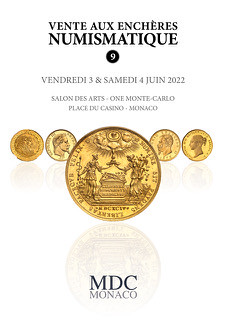
- A beautiful selection of ancient coins, Greek and Roman, as well as a collection of Gallic coins.
- For French coins, several great rarities will be offered for sale: a Royal d'Or of Louis IX, a Franc à Cheval of Charles VII or an exceptional medallion of Louis XIII and Marie de Medici in gold.
- Among the foreign coins, we note a nice set of Chinese coins, rarities for Great Britain, Mexico, or Romania, etc...
- For Italy and Venice, we must note a collection of gold oselles (multiples of gold offered directly by the doge), some of them struck in Murano, among the most beautiful known.
A prestigious 408-page catalog with numerous enlargements and historical comments will be available. LIVE participation will be possible on the BIDDR.CH platform.
Lot 114.
Vitellius (69). Aureus 69, Tarragona.
Obv. A VITELLIVS IMP GERMANICVS. Laureate head left.
Rev. LIBERTAS RESTITVTA. Liberty standing right with a spear and the pileus.
RIC 9 (R2) - Calicó 564 ; Gold - 7,31 g - 19 mm - 6 h. Provenance Schulman Vault Collection auction NGC MS* 4/5 3/5 flan flaw. Slight planchet flaw on the cheek. Striking and high relief portrait. Close to its mint state with its original lustrous largely present. Mint State. Price: 100000€
Lot 230.
Westphalia, Jérôme Napoléon (1807-1813). 40 frank 1813, C, Kassel.
Obv. HIERONYMUS NAPOLEON, Jérôme Napoléon's Laureate head left, below signature Tiolier.
Rev. KOENIG V. WESTPH. FR. PR./ (Mint Mark) (date) (Engraver Mark), Wreath made of connected branches and leaves, in the center : 40 FRANK.
DMP.742 - Fr.3516 ; Gold - 13,10 g - 26 mm - 6 h. Top Pop (2) : The finest graded ! NGC AU 55. Edge inscription. Extremely rare original mintage! Heavyweight with over 13 grams. Coin alignment. small handling marks and regular wear of the reliefs. Nice golden patina on the original lustrous. About Uncirculated. Price: 100000 €
Lot 264.
Léopold Ier (1618–1632). Module de 7 1/2 ducats, Léopold and Claudia of Médicis wedding ND (1626), Hall.
Obv. * LEOPOLD. AR: D: AV. E. CLAVDIA. ARCHIDVCISA. AV. MEDIC. Busts adjoined, crowned and cuirassed, right.
Rev. DVX. BVRGVNDIÆ. COMES. TIROL. Crowned and displayed eagle face-on, under a crown.
Fr.180 (8 ducats) ; Gold - 25,91 g - 39 mm - 12 h. Top Pop : this is the only coin graded ! Provenance Rudolf Scherer, Wien, Münzen-Sammlung, oktober 1912 (von Morosini, Preis K550 ; Achtducatenstück) NGC AU 55. Utmostly rare. Extremely fine. Price: 100000 €
Lot 411.
Charles VII (1422-1461). Franc à cheval ND (c.1424), Montpellier.
Obv. KAROLVS: D - EI: GRACIA: - FRACORVM: REX. King on horseback, galloping to the left, sword raised, crowned with a helmet, wearing over his hauberk a fleur-de-lys coat of arms; horse's caparison is fleur-de-lys.
Rev. (clover) XPC: VINCIT: XPC: REGNAT: XPC: IMPERAT. Cross with fleur-de-lys and leafy with quatrefoil in heart, with a K in 1 and 4, within a quatrefoil adorned with two lilies and with clovers.
Dy.451 - L.455 - Fr.302 ; Gold - 3,03 g - 27 mm - 4 h. The second highest graded after the MDC 7 n° 225 (Toulouse). Provenance the collection X.. (ex. reported by Lafaurie) then Künker auction 201, February 2, 2012, N° 21 PCGS AU55. This is the last royal franc strucked! One of the greatest rarities of French royal numismatics. Nice mintage fairly neat and well centered. About uncirculated. Price: 200000 €
The franc à cheval of Charles VII is known from only three examples, two for Toulouse and one for Montpellier. For Toulouse, one copy is kept in the Cabinet des médailles of the Bibliothèque nationale de France; the second known copy was sold at MDC 7 auction n° 225. For Montpellier, the mintage is known by the mention of Lafaurie in 1951, coll. X.. probably the copy of the Künker auction in February 2012 and which is our copy, unique! The manufacture of Toulouse is attested by the Archives, while those of Montpellier are missing. For Toulouse, the franc à cheval was made between July 8 and August 21, 1424, with a value of 24 carats (1000 thousandths) and a weight of 80 pieces per marc, i.e. 3.059 g. Were used 56 marcs 2 ounces of fine gold (13,76 kg) to manufacture 4500 specimens, as the register of the National Archives Z1b 992 indicates: "C'est le compte d'une boueste de la Monnoye de Tholose de deniers d'or fin appelez frans à cheval qui ont cours pour XX sols tournois la pièce, à XXIIII caraz et à demi-carat de remède, de IIIIxx de poys au marc de Paris, fait en achat par Jehan de Veyrières pour lequel Jobert Vidal a tenu le compte du VIIIe jour de juillet inclus mil IIIIcXXIIII que la première délivrance fu faicte jusques au XXIIe jour d'aoust exclus ensuivant oud. an, en laquelle avoit XV deniers d'or qui font IIIImVc deniers d'or, poisent LVI mars II onces d'or". For Montpellier, the archives are missing. We also note, according to Jean Duplessy, that 200 copies were struck in Romans on July 1, 1424.
Lot 735.
Second Empire / Napoleon III (1852-1870). Pattern 100 francs laureate head, special mintage 1862, E, Paris.
Obv. NAPOLEON III EMPEREUR. Laureate head right, below (Engraver Mark) and signature BARRE.
Rev. EMPIRE FRANÇAIS (date). Value around the imperial arms on a crowned mantle and broaching the sceptre and the hand of justice.
G.1136 - Maz.1603 - VG.3613 ; Gold - 32,18 g - 34,8 mm - 6 h. Top Pop : The finest graded ! PCGS SP67. Special mintage with glazed mirror fields and sanded reliefs, of an exceptional quality of presentation. Vintage between two anchors on the reverse. Mint state. Perfect and very rare coin. Mint State. Price: 200000 €
Lot 737.
Second Empire / Napoléon III (1852-1870). 100 francs laureate head 1870, A, Paris.
Obv. NAPOLEON III EMPEREUR. Laureate head right, below signature BARRE.
Rev. EMPIRE FRANÇAIS (date). Value around the imperial arms posed on a crowned mantle and broaching on the scepter and the hand of justice.
G.1136 - F.551 - Fr.580 ; Gold - 32,25 g - 35 mm - 6 h. Top Pop : The finest graded by PCGS ! PCGS MS62. Small flat on the ribbon end and high reliefs, with minimal handling marks in the fields. Retains a nice color and the original lustrous visible under a patina that has slightly browned the fields. Utmosly rare. Mint State.
Only two copies engraved by PCGS, in AU55 and our copy in MS62 and four copies engraved by NGC, one in 53, one in 61 and two in 62. Our copy is certainly the most beautiful of the three copies engraved in 62. Price: 250000 €
Lot 916.
Guillaume III (1694-1702). 5 guineas, 2nd bust 1701, London.
Obv. GVLIELMVS. III. DEI. GRA. Laureate bust on the right.
Rev. MAG. BR. FRA. ET. HIB. REX (date). Cross formed by four crowned shields, with arms in heart, and canted by four scepters.
Fr.310 - S.3456 - KM.508 ; Gold - 41,66 g - 37 mm - 6 h. NGC MS 62+. With bust with large wig and full scepters. The edge is inscribed: + DECVS. ET. TVTAMEN. ANNO. REGNI. DECIMO. TERTIO +. This examplar has hardly circulated with the bust perfectly detailed on the right. Nice yellow-orange color. Mint State. Price: 120000 €
Lot 927.
Victoria (1837-1901). 5 pounds Una and the lion
, Proof 1839, London.
Obv. VICTORIA D : G : BRITANNIARUM REGINA F : D : bust facing left, wearing headband ; signature W . WYON R. A.
Rev. DIRIGE DEUS – GRESSUS MEOS. The queen facing left leading a lion with her sceptre : (date) and signature W . WYON R. A. in exergue.
Fr.386 – S.3851 – W&R.278 – Schl.148 ; Gold – 38.52 g – 37 mm – 12h. From the St James Auctions Ltd 11, 8th may 2009, n°244, then St James Auctions Ltd 17, 24th may 2011, n°211. NGC PF 62 ULTRA CAMEO. Proof. Edge : DECUS ET TUTAMEN ANNA REGNI TERTIO. Minimal hairlines on the mirror surfaces with ultra cameo. Mint State. Price: 150000 €
Conceived by William Wyon (1795-1851) in 1839 to commemorate the beginning of queen Victoria's reign (1837),
the Una and the lion
5 pounds is considered one of the most beautiful british coins. Victoria, standing with a lion, is
moving left, with the motto May God direct my steps
above her. The young queen, 20 years old, is represented as
Lady Una, from Edmund Spencer's The Faerie Queene, a poem written in 1590. This is the first time a british monarch
is represented as a fictitious character : England as a lion is guided by Una, personified by queen Victoria, and her
sceptre.
Lot 1082.
Victor-Emmanuel II (1861-1878). 100 lire 1878, R, Rome.
Obv. VITTORIO EMANUELE II. Bare head facing left, signature FERRARIS and (date) below.
Rev. REGNO D'ITALIA. In a two-branchs wreath, a crowned shield circled by the Supreme Order of the Most Holy Annunciation's collar, (mint) L.100 below.
Cud.1188c - P.453 - KM.19.2 - Fr.9 ; Gold - 32,25 g - 35 mm - 6 h. Top Pop : this is the highest graded example ! From Varesi 71, 10th November 2017, n°490. PCGS MS65. Only 294 struck and this is the most beautiful known ! Gorgeous strike with slightly satin reliefs and mirror fields. Uncirculated. Price: 150000 €
Lot 1091.
Victor-Emmanuel III (1900-1946). Gold 100 lire pattern, the lion quadriga by S. Johnson, special strike 1906, Milano
(Johnson).
Obv. VITTORIO EMANVELE III. Bare head facing right, signature EB and (date) below.
Rv. REGNO D'ITALIA (date). Allegory of Italy as Cybele, stading in a charriot pulled by four lions facing right. Below, a cartouche containing LIRE CENTO ; PROVA to the left and signature S.J. to the right.
Pag.P- (cf.140) - Luppino PPSJ3 - KM.Pr4 ; Gold - 32,25 g - 35 mm - 6 h. Top Pop : highest graded example ! PCGS SP64. Special strike with satin reliefs and mirror fields. Very rare. Mint State. Price: 100000 €
Lot 1093.
Victor-Emmanuel III (1900-1946). Gold 100 lire pattern, the Agriculture by S. Johnson, Matte Proof 1907, Milano
(Johnson).
Obv. VITTORIO EMANVELE III. Bust in uniform, bare head facing left, Savoy knot and signature EB in front.
Rev. REGNO D'ITALIA. Allegory of Italy standing to the right, head turned backwards, holding a sheaf of ears and a plow, L.100 to the right ; cartouche containing EB. PROVA (date) and S. J. in exergue.
Pag.P144 - Luppino PPSJ12 ; Gold - 32,48 g - 35 mm - 6 h. Top Pop : highest graded example ! NGC PF 64 MATTE. Very rare. Mint State. Price: 100000 €
Lot 1152.
Carol II (1930-1940). 100 lei, centenary of Carol I birth, with large cupboards 1939, Bucharest.
Obv. CAROL II REGELE ROMÂNIOR. Head facing right, signature E. W. BECKER below.
Rev. 100 LEI / ROMANIA. Four branchs cross adorned with lilies, on a crown, a shield on top, and surrounded by (date).
KM.XM7 - Stamb.171 - Fr.13 ; Gold - 35 mm - 6 h. Top Pop : highest graded example ! NGC MS 64. Very rare, remarkable quality, with original mint lustre. Most likely the most beautiful example known ! Uncirculated. Price: 150000 €
Lot 1265.
Annam, Tu Duc (1848-1883). Lang, gold strike, no date (1848-1883).
Obv. Around the central hole : Tu Duc thông bao, to the left ; Van thê vinh lai, to the right ; the moon and the sun under clouds, above ; the three mountains with longevity's trees in the middle of the sea, below.
Rev. Written in chinese, a quatrain The precious stone khuyet and the cinnabar, in a thousand years, become pure gold,
transmissible to ten thousands generations. Thereby, we aknowledge the merit and we emphasise the virtuous men,
because only wisdom is precious.
Schr.403 - KM.559 - Fr.32 v. ; Gold - 37,77 g - 65 mm - 12 h. Top Pop : Highest graded example ! NGC MS 62. Very discrete double-strike on the obverse for this impressive module ! Beautiful yellow with golden reflections. Well-centered and good engraving. Very rare. Mint State. Price: 120000 €
For more information, see:
https://or-numismatique-monaco.com/en/
1715 FLEET SPANISH PHILIPPE V ROYAL 8 ESCUDOS
A rare "Royal" 8 escudos from the 1715 Fleet is offered in the June 3-4 MDC Monaco auction. Here's a standalone article I excerpted from the press release. A great item. See the earlier article for more information on the sale. -Editor
Lot 1110.
Philippe V (1700-1746). Royal
8 escudos (special strike) from the Spanish silver fleet of 1715, Mexico.
Obv. *PHILIPPVS* V* DEI* G* (date)*. Crowned arms of Castilla and Leon, Catalonia, Aragon, Sicilia, Austria, Burgundy, Brabant, Flanders, Tyrol and Bourbon, surrounded by *(mint) (assayer) and *VIII*
Rev. *HISPANIARVM* INDIARVM* REX. Cross potent, lilies in each angle pointing to the center, in a quatrefoil surrounded by four tulips.
Aureo 2196 – Cal.291 – Cayon.9950 – Onza.401 – KM.R57.3 – Fr.7 ; Gold – 27 g – 35 mm – 12h. This is the second highest graded by NGC, the first one graded MS66 and this one MS62, coming from a Spanish silver fleet's wreck of 1715.
NGC MS62 (Shipwreck certification). Big rosettes' variety on the reverse. Letter J for José Eustaquio de Leòn, assayer. Very rare, with only 5 known examples and for a recently discovered date. Assay's traces on the edge with minor marine corrosion on the surface (certified by NGC, coming from 1715 Fleet shipwreck). However, reliefs are specially processed in the die, giving a satin effect to this example, almost in mint state, never having circulated. Uncirculated. Price: 250000 €
This coin is a royal
8 escudos, well-struck, on a prepared planchet, medal alignment, far above the quality of the cob
8 escudos quickly and poorly struck on irregular flans. Only 40 coins of the royal
8 escudos are known for twelve
dates between 1680 and 1732 (1695, 1698, 1702, 1711, 1712, 1713, 1714, 1715, 1717, 1723, 1728 and 1723, and maybe
1718 but still non-confirmed). Our specimen is almost perfectly struck, only showing traces of a minimal double-struck,
necessary to rise the reliefs of the coin during the manual strike. Due to similar making, the coins dated 1714 and after
could have been struck using the screw press, a mechanical process that could explain the different aspect of those late
coins.
The few royal
8 escudos known, originally struck for the Royal Court of Spain and for dignitaries, are coming
from recent submarine archeological discoveries of the 1715's treasure of the Spanish fleet. On the 24th july 1715, an
eleven ships fleet leaves Havana to go north-east, off Florida, before crossing the Atlantic, going to Spain with American
treasures such as Peruvian and Columbian objects, precious stones, porcelain, silver and gold coins. Those treasures
were sent to Spain to fill the financial pressing needs of the Spanish court.
On the 31st july 1715, the ships encounter a
hurricane killing 1500 officers and sailors whereas the shipment is scattered. Survivors inform authorities and a rescue
mission is launched to help the shipwrecked and get the treasure back. For months, Spain recovers artefacts and millions
of coins, even if pirates harass the operation. In 1718, the rescue mission is ended, considered as a success, even if lots
of artefacts and coins are left undiscovered. They are retrieved at the end of the XXth and the beginning of the XXIth
century, when 8 out of the 11 ships are recovered on the treasure coast
. Sales are set up, after the State of Florida preempts 20% of the discoveries, since 1964. In 2015, 10 royal
8 escudos were retrieved, dated 1711 (7), 1712 (2) and
1715 (1). Those royal
8 escudos are considered as the most beautiful American colonial coins.
Next week, we'll have an additional article about another great lot in the sale. -Editor
STACK'S BOWERS TO OFFER SYD MARTIN COLLECTION
In this blog post, Stack's Bowers announces their upcoming sales of the collection of former ANS President and Numismatic Bibliomania Society Governor Syd Martin. What a great event! Sales like these come around once in a generation, at best. -Editor
Did you know that Stack's Bowers Galleries has been selected to sell Sydney F. Martin's many remarkable numismatic collections at public auction over a several year span, beginning in 2022. Stack's Bowers Galleries has sold most of the finest collections of pre-Federal coins presented at auction over the last 50 years.
"Our world-class expertise in this specialized area was a natural pairing with Mr. Martin's world-class collection," said Brian Kendrella, Stack's Bowers Galleries president. "After spending years of his life and millions of dollars building one of the finest numismatic cabinets of all time, Syd left very particular instructions on how the cabinet should be dispersed. We're grateful that we are able to provide all the aspects he sought from a numismatic auction firm."
The Martin Collection could be compared to the Norweb Collection (sold by Bowers and Merena in 1987-88) in its expansiveness and its inclusion of headline rarities, but it's both bigger and deeper than Norweb. It could be compared to Garrett (1979-81) or Ford (2003-13), but either comparison underestimates the breadth of series that Martin explored. The collection of Connecticut coppers is both the most complete and most important ever assembled. The collections of other early copper series, notably including the New Jerseys, is similarly important. The series that Syd Martin collected and researched vigorously enough to produce new standard references — the St. Patricks, the coinage of William Wood, and the French colonial series — are unlike any collections that have ever been formed or could conceivably be formed again. Massachusetts silver, colonial type coins, Fugio coppers, coins and medals of George Washington, Betts medals, and more, are all present in world-class quality.
The cataloging of the Martin Collection will focus on Martin's unique approach and important legacy, with early American expert John Kraljevich leading an experienced Stack's Bowers Galleries team. Kraljevich and Martin's friendship dates back decades, to small town shows in their native Pennsylvania, and continued as both grew in experience and expertise.
"It's an honor to have a chance to contextualize Syd's amazing efforts and bring them — and his coins — not only to a new generation of collectors, but to pages that will memorialize his contributions for numismatists not yet born," Kraljevich said. "The man was the total numismatist: scholar, writer, collector, and companionable colleague. I'm so thankful he did so much work to improve the community of numismatic scholars and collectors, and we all owe him a debt. These catalogs are one way we can say thanks."
The first selection of items from the Sydney F. Martin Collection will be offered at the August 2022 Global Showcase Auction, August 22-27, with lot viewing available in Rosemont, Illinois, concurrent with the ANA World's Fair of Money.?
To read the complete article, see:
Stack's Bowers Galleries to Present Sydney F. Martin Collection
(https://www.stacksbowers.com/News/Pages/Blogs.aspx?ArticleID=sydney-f-martin-collection-presented-by-stacks-bowers-galleries)
To read earlier E-Sylum articles, see:
SYDNEY F. MARTIN (1945-2021)
(https://www.coinbooks.org/v24/esylum_v24n04a02.html)
ROGER SIBONI REMEMBERS SYD MARTIN
(https://www.coinbooks.org/v24/esylum_v24n04a03.html)
MORE ON SYD MARTIN
(https://www.coinbooks.org/v24/esylum_v24n04a04.html)
KOLBE & FANNING SYD MARTIN LIBRARY RESULTS
(https://www.coinbooks.org/v25/esylum_v25n18a02.html)
NUMISMATIC NUGGETS: MAY 20, 2022
Here's a selection of interesting or unusual items I came across in the marketplace this week. Tell us what you think of some of these. -Editor
Thraco-Macedonian tribes, The Edones
King Getas, circa 479-465. Octodrachm circa 479-465, AR 28.97 g. Nude herdsman or local hero walking between two bulls r. Rev. GI?? ?? – S???V – S E?O? – ?O? retrograde Four-spoked wheel within quadripartite incuse square. Svoronos, Hellénisme Primitif, p. 46 cf. 3 and pl. IV, 19. AMNG III, pl. XXVII, 30. Tatscheva 2 var.
An unusual design. From the Numismatica Ars Classica NAC Auction 126, lot 61 (Sorry, this one's been sold). -Editor
To read the complete lot description, see:
Auction 126, lot 61
(https://www.arsclassicacoins.com/biddr/#!/auction/lot?a=2061&l=61)
CANADA. Quebec. Montreal. Copper Cent Token, ND (1885). PCGS MS-63 Red Brown.
BR-582. Mintage: 200. Obverse: Inscription in 10 lines advertising Joseph LeRoux's numismatic works; Reverse: Same inscription in French. Offering handsome and mostly red surfaces, this charming piece displays incredible attractivity and is certain to appeal to specialists.
A nice piece advertising numismatic literature! From the Stack's Bowers June 2022 World Collectors Choice Online Auction. -Editor
To read the complete lot description, see:
CANADA. Quebec. Montreal. Copper Cent Token, ND (1885). PCGS MS-63 Red Brown.
(https://auctions.stacksbowers.com/lots/view/3-WWIZG/canada-quebec-montreal-copper-cent-token-nd-1885-pcgs-ms-63-red-brown)
BOHEMIA. Prague. 50th Birthday of Wilhelm Trinks Oval Bronze Medal, 1891. GEM UNCIRCULATED.
Hauser-7940; Horsky-7704. By Jauner. Dimensions: 53mm x 63mm; Weight: 93.10 gms. Obverse: Draped bust left; Reverse: Pallas Athena seated right, holding spear and cradling figure of Victory; garnished shield with head of Medusa to left; to right, putto next to money chest, holding up a coin; owl to lower right. Edge: Plain. Incredibly glossy surfaces and an olive-brown nature highlight this immensely majestic numismatic-themed medal. Trinks was a Prague-based coin dealer, hence the money chest and reverse legend "IN NUMMIS VERITAS," or, "there is truth in numismatics."
The super-long beard is what first caught my eye, but this oval medal featuring Prague-based dealer Wilhelm Trinks is all about numismatics. Also from the Stack's Bowers June 2022 World Collectors Choice Online Auction. -Editor
To read the complete lot description, see:
BOHEMIA. Prague. 50th Birthday of Wilhelm Trinks Oval Bronze Medal, 1891. GEM UNCIRCULATED.
(https://auctions.stacksbowers.com/lots/view/3-WWI3Q/bohemia-prague-50th-birthday-of-wilhelm-trinks-oval-bronze-medal-1891-gem-uncirculated)
UNITED STATES OF AMERICA. France - United States. Battle of Cowpens Bronze Medal, "1781" (ca. mid-20th Century). Paris Mint. UNCIRCULATED.
Betts-595. Comitia Americana series. Restrike issue. By Duvivier. Diameter: 46mm; Weight: 49.20 gms. Obverse: Colonel John Eager Howard, wielding sword, on horse rearing right; to right, fleeing British soldier; Victory in background, holding wreath and palm frond; Reverse: Legend and date in seven lines; all within wreath. Edge: [cornucopia] BRONZE. Olive-brown matte surfaces.
If an original gold Comitia Americana medal is beyond your collecting budget, how about a nice bronze Paris Mint restrike? Also from the Stack's Bowers June 2022 World Collectors Choice Online Auction. -Editor
To read the complete lot description, see:
UNITED STATES OF AMERICA. France - United States. Battle of Cowpens Bronze Medal, "1781" (ca. mid-20th Century). Paris Mint. UNCIRCULATED.
(https://auctions.stacksbowers.com/lots/view/3-WVBXM/united-states-of-america-france-united-states-battle-of-cowpens-bronze-medal-1781-ca-mid-20th-century-paris-mint-uncirculated)
Francés Indo-China Elefantes Laos Bronce 59mm
A great piece, from the eBay offerings of Hedley Betts. -Editor
To read the complete lot description, see:
Francés Indo-China Elefantes Laos Bronce 59mm
(https://www.ebay.com/itm/165478193029)
COLORIZED POLYMER NOTE: YEAR OF THE MONKEY
I don't know what this is (a fantasy note, I imagine), but it's got a striking colorful image. -Editor
To read the complete lot description, see:
2016 BANK OF KAMBERRA 50 NUMISMAS CRISP UNC
(https://auctions.bidalotcoinauction.com/lots/view/1-5W6S65/2016-bank-of-kamberra-50-numismas-crisp-unc)
Country: Ukraine
Denomination: 20 hryven
Price: $12.00
Catalog #: 1sb
Product ID: 22043001
Year: 2022
Grade: UNC (uncirculated)
Other Info: Reed paper fantasy art private issue note. Back design is based on a real stamp issued by the Ukrainian post office and shows a soldier "giving the finger" to a Russian ship, the Moskva, that was demanding the soldiers surrender, (later sunk by Ukrain). This design was based on a sketch by Boris Groh. Variety w/properly aligned "20" registration & lighter portrait.
Coloration: Green & brown / blue & yellow..
Depictions: Portrait of President Volodymyr Zelenskyy with mountains behind on front; Ukrainian soldier flipping off a Russian warship on back. Includes a special message for Vladimir Putin near bottom of ship!.
Note Size: 5 7/8" x 3 1/4"
Watermark: Repeating triangles.
Security Features: Watermark, covert UV features, registration..
Speaking of fantasy banknotes, Reed Banknote just came out with a new one for Ukraine. The first one sold in a charity auction benefitting Doctors Without Borders. -Editor
To read the complete item description, see:
https://www.currencybanknotes.com/banknotedetail.php?id=15065
A CLASSIC AGRIGENTUM TETRADRACHM
Here's another interesting coin I came across this week in the Numismatica Ars Classica NAC Auction 132. For more varieties of wildlife than typically depiced on coins. -Editor
Sicily, Agrigentum Tetradrachm circa 420-415, AR 17.34 g. ??R?G – ????? – ? – ? Eagle l., with wings spread, perched on dead hare lying on rock against which rests a murex and a cockle-shell. Rev. Crab; in l. field, a cockle-shell. Beneath, a large fish (polyprium cernium) swimming l. Seltman, NC 1948, pl. I, i (this obverse die). Gulbenkian 163 (this obverse die). AMB 257 (this obverse die). Kraay-Hirmer 163-164 (these die). Rizzo pl. I, 16 (this obverse die). Boston, MFA 235 (this obverse die). Westermark, Akragas 529. Very rare and in exceptional condition for the issue, among the finest specimens known.
A magnificent representation of masterly style, perfectly centred on an exceptionally broad flan. Wonderful light tone and good extremely fine From a Swiss collection, privately purchased from Tkalec in 1995 and notarized as being in Switzerland prior to 2004.
The designs of this rare Agrigentum tetradrachm are a feast of nature in all three media – the sky, the land and the waters. The detailed depiction of the creatures reveals that this engraver was not only a talented artist, but a keen observer of the natural world. In that sense this piece ranks among the masterworks of the Classical period, for there is no attempt to idealize the subjects, only to show them in their truest form.
The obverse depicts creatures from all three media by the fanciful addition of a cockleshell and a murex shell to the rocky mount upon which the eagle devours the prey only moments before it had snatched from the land beneath. The reverse limits its subject matter to the waters, but in doing so shows an exciting array, including a giant ocean perch, a crab and a cockleshell, representing three of the principal categories of creatures that reside in the waters. Though there are many varieties within the murex family, the shell here may represent the murex bandaris, from which the royal purple die was famously extracted.
"Love of splendour, fairest of mortal cities, home of Persephone! Thou that inhabitest the hills of noble dwellings above the banks, where feed the sheep beside the stream of Acragas! I beseech thee, Queen, along with the kindly favour of gods and men, graciously to welcome at the ends of renowned Midas, this coronal from Pytho, I beseech thee also to welcome himself, as a champion of all Hellas in the art, which Pallas Athene invented when she wove into music the dismal death-dirge of the Gorgons bold."
Thus the great Theban poet Pyndarus opens the XII Pythic, with a cletic hymn to the city of Acragas to welcome its son Midas (not an athlete, but a flautist and twice winner of the Pythian games in 490 and 486).
To read the complete lot description, see:
Auction 132, lot 181
(https://www.arsclassicacoins.com/biddr/#!/auction/lot?a=2504&l=181)
BETTER-DATE SAINT GAUDENS MARKET INTEREST
There's a clever graphic atop this Greysheet article by John Feigenbaum about recent market interest in better-date Saint Gaudens gold coins. A 1931 graded MS65 realized $312,000, more than double the price bought by a similar coin two years ago. Headline: "The Saints are (Finally) Marching!" That tune will be in my head all day now. -Editor
After years of mediocre performance, the Saint Gaudens series has taken off over the past 12 months. The lack of interest in, what is arguably the most popular U.S. series of coinage, was a head-scratcher. Part of the problem is that the vast majority of "Saints" on the market are the same handful of dates that exist in the tens of thousands. Even in higher grades (MS60-64) these coins are everywhere and trade relative to their intrinsic (metal-based content) value. It's no wonder collectors and investors fail to get excited about them.
There are many other issues in the series that are slightly-better (like the 1908-S, 1922-S) to quite rare (1931) and highly sought. Illogically, these were being overlooked and levels had been flat for a long time -- until recently.
Why???
The match lighting the tinder box occurred with the sale of the unique-in-private-hands 1933 Saint Gaudens in June 2021. This was a game changer. Greysheet editorial contributor, Greg Reynolds, wrote an important story at the time. This sale seems to have shocked buyers into attention for the numerous rarities in the series and prices at auction are shooting up, after years of malaise.
All of this suggests that we are seeing renewed interest and demand for dated U.S. gold material and the buyer base is much greater than it had been. Taken individually, these coins are quite scarce and there's no depth of inventory to sustain great demand so new levels are eye-popping.
To read the complete articles, see:
1933 Double Eagles, Part 1: Analysis of The Auctions
(https://www.greysheet.com/news/story/1933-double-eagles-part-1-analysis-of-the-auctions)
The Saints are (Finally) Marching!
(https://www.greysheet.com/news/story/the-saints-are-finally-marching)
MICHAEL ARMITAGE TO DESIGN NEW POUND COIN
David Pickup passed along this article about the Royal College of Art's announcement of a planned new design from the Royal Mint for the reverse of the standard circulating one pound coin. The new design itself has not been revealed yet. The image shows one of the previous reverse designs. The obverse, of course, displays the Queen. -Editor
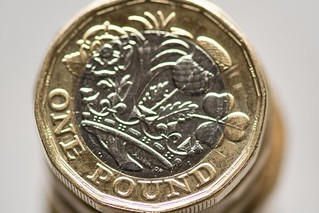 Artist Michael Armitage will design a new £1 coin which will enter circulation next year, Chancellor Rishi Sunak has announced.
Artist Michael Armitage will design a new £1 coin which will enter circulation next year, Chancellor Rishi Sunak has announced.
The new design for the reverse or tails
side of the coin will mark its 40th anniversary and it will be revealed later this year.
During a Royal College of Art's (RCA) reception on Tuesday, Mr Sunak announced that Mr Armitage's new design will celebrate the culture, creativity, and heritage and history of the UK in the 21st century.
Mr Armitage said: It is a great privilege to have the opportunity to collaborate with the Royal Mint on the design of the new £1 coin.
It is an honour to be part of the lineage of coin-making in the United Kingdom and I am grateful to the Chancellor and the selection panel for the opportunity to contribute to this history in considering what it is to be part of Great Britain today.
Chief executive of the Royal Mint Anne Jessopp said: The £1 coin is a symbol of Britain that is recognised around the world.
Mr Armitage was born in 1984 in Nairobi, Kenya, and lives and works between London and Nairobi. Earlier this year, the Royal Academy of Arts, London, elected him a Royal Academician in the category of painting.
He was chosen by the Chancellor on advice provided by an independent panel with expertise in coin design and art.
The 1983 £1 coin was fully redesigned in 2017, including the introduction of new security features.
David adds:
"There is not much on this story about a commemoration of forty years of the pound coin which replaced the banknote. The modern twelve sided version is probably much better than the first designs. At one point it was estimated that 3% of the old pound coins in circulation were fake."
Thanks! We'll await more information on the new design. The article does say the new coin will incorporate anticounterfeiting features. -Editor
The design will become the standard circulating £1 coin and will include the current world-leading
high-security features to protect against counterfeiting, the Treasury said.
To read the complete article, see:
Artist Michael Armitage to design new £1 coin
(https://www.wiltsglosstandard.co.uk/news/20129149.artist-michael-armitage-design-new-1-coin/)
Here's a Royal Academy article with more information on the artist. -Editor
 In his paintings Armitage weaves together his experiences in Kenya and current events with contemporary East African art and European art history. With his multi-layered narrative paintings, Armitage questions social norms, religious ideology, politics and cultural clichés.
In his paintings Armitage weaves together his experiences in Kenya and current events with contemporary East African art and European art history. With his multi-layered narrative paintings, Armitage questions social norms, religious ideology, politics and cultural clichés.
Armitage was born to a Yorkshireman father and Kikuyu mother, spending his childhood in East Africa before training as an artist in Britain.
He has since described his education at the Slade School of Fine Art and the Royal Academy Schools as stripping everything back to the basics and building it back up again, which was essential, if not enjoyable.
His work has been influenced by these years of studying Western art history, and particularly by Paul Cézanne, Edgar Degas, Francisco Goya, Edouard Manet and Titian, but is grounded in East Africa and inspired by artists such as Jak Katarikawe, Chelenge van Rampelberg and Meek Gichugu.
To read the earlier E-Sylum article, see:
A beginner's guide to Michael Armitage
(https://www.royalacademy.org.uk/article/michael-armitage-beginners-guide)
FAKE CANADIAN FAKE TWO-DOLLAR COINS SEIZED
Speaking of counterfeit circulating coins, this article discusses fake Canadian two-dollar coins, or "toonies". -Editor
A Richmond Hill man is facing charges after RCMP identified and seized 10,000 counterfeit toonies.
The charges stem from an investigation dating back to last summer, when the Royal Canadian Mint discovered an ongoing counterfeit currency problem through their random sampling process. From there, the Greater Toronto Area's Trans-National Serious and Organized Crime Section opened an investigation that focused on finding those who were involved in the circulation of the faulty coins.
Counterfeit Toonies: The genuine coin on the left versus the counterfeit on the right. Genuine: Fine details of the bear's paws. 2a: The polar bear's paw is misshapen.
During this time, Mounties seized about 10,000 fake two-dollar coins, which had been distributed in the banking system and had one specific detail flaw that distinguished them from real coins. The main way to identify these counterfeit coins is the split-toe on the right front paw of the Polar Bear side of the coin, which instead resembles a claw.
Daixiong He, 68, is charged with uttering counterfeit money and possession of counterfeit money. He was arrested and released on an undertaking but is set to appear in a Newmarket court on June 2.
To read the complete article, see:
Don't be fooled by fake toonies: RCMP seizes thousands of fakes with a botched polar bear 'claw'
(https://sports.yahoo.com/fake-toonies-rcmp-counterfeit-171211935.html)
LEPROSY COINS
On the American Numismatic Association website the Coleccionistas de Monedas's Blog has a nice article about coins and tokens related to leprosy. Check it out - here's an excerpt. See the complete article online. -Editor
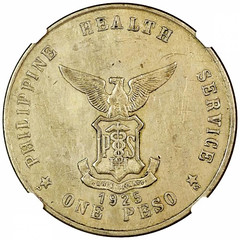 Leprosy is perhaps the most feared disease in history, reported in millenary texts and universally popularized by its numerous mentions in the Bible. However, although this bacillus is not transmitted by contact, but through the airways when breathing, coughing or talking, different countries minted coins for prophylactic purposes since the early twentieth century for the exclusive use of leprosaria located in their territory.
Leprosy is perhaps the most feared disease in history, reported in millenary texts and universally popularized by its numerous mentions in the Bible. However, although this bacillus is not transmitted by contact, but through the airways when breathing, coughing or talking, different countries minted coins for prophylactic purposes since the early twentieth century for the exclusive use of leprosaria located in their territory.
This disease led to millennia of segregation and isolation measures for those who had the misfortune to suffer from it. In this article we will provide all the information on this phenomenon and the best known coins that were minted for this purpose.
Colombia, a pioneer in coins for leper houses
The oldest known official coins belong to the Colombian leprosarium of Agua de Dios, Caño de Loro and Contratación. Bogota minted four series: 1901, 1907, 1921 (copper) and 1928 (nickel). The denominations ranged from centavo to 10 pesos. The design included a cross with the word "lazareto", the value, year, the legend "República de Colombia" (Republic of Colombia) and, in some cases, the national coat of arms and place of manufacture.
Venezuelan Coins
Venezuelan coins appeared in 1913 in the name of the Maracaibo lazaretto, located on the island of Providencia, in the western part of the country, while others were issued in 1916. Made of brass, they included on the obverse side the name of the leprosarium and the year, while the reverse side showed the value, from 5 centavos to 20 bolivars.
In 1936 a new series was minted for the Cabo Blanco leprosarium in the center of the country. The issues would conclude in 1939, when Maracaibo received its last pieces. The variations between coins would be typographic, in their typeface (denticles vs. dots), edge (smooth vs. striated) and presentation of the denominations (fractions vs. decimals).
The Philippines and the Culion Island Lazaretto
The United States occupied the Philippines between 1898 and 1946, creating the leprocomium on Culion Island, and minting between 1913 and 1930 coins ranging in value from ½ centavo to peso. The first series were struck in aluminum (1913, 1920) and cupro-nickel (1922); they showed on the obverse a caduceus, the legend "Bureau of Health", later "Philippine Health Service", and the year; the reverse displayed the value accompanied by the inscriptions "Culion Leper Colony" and "Philippine Islands".
To read the complete article, see:
Coleccionistas de Monedas's Blog
(https://www.money.org/collector/user_74883/blog/leprosy-coins-an-almost-unknown-numismatic-phenomenon)
ISRAEL PRESENTATION MEDALS
Aaron Oppenheim writes:
"After reading Michael Oppenheim's (no relation!) contribution to last week's E-Sylum I found a couple of examples in my collection that would fall into the same category."
Thanks. Here are Aaron's images and descriptions. Great medals! -Editor
Henry C. Bernstein (no apparent relation to Leonard Bernstein!) was active in United Jewish Appeal organizing fundraising events to benefit the State of Israel. Here's the presentation medal he received with his name engraved on the cover of the olive wood box. It contains the 1963 U.J.A. State medal.
Another even earlier official presentation numismatic item is that given to Mr. and Mrs. Leo A. Yanoff by the Government of Israel - the Jewish Agency for Israel.
Dated August 1958 and ‘Jerusalem', the silver engraved plaque covers virtually the entire olive wood case and contains the first silver commemorative issued by the State, ten years after its founding.
To read the earlier E-Sylum article, see:
JEWISH PRESENTATION MEDALS
(https://www.coinbooks.org/v25/esylum_v25n19a34.html)
THE BOOK BAZARRE
FINDING AN OLD SAFE
Wouldn't we all love to find an old safe in the old house we just bought? I followed a clickbait headline to this article about such a find. -Editor
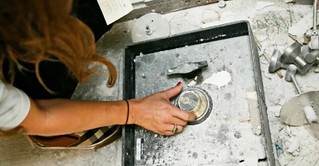 Once Jack had moved the old cabinet away, he noticed something in its place -- a circular notch on the floor. There was a handle on the item on the floor.
Once Jack had moved the old cabinet away, he noticed something in its place -- a circular notch on the floor. There was a handle on the item on the floor.
It seemed like a giant plug built into the floorboards, but why? He pulled hard on the plug to reveal something that had been hidden for a long time.
When Jack pulled on the metal ring that had been built into the floor, a square-shaped panel of floorboards came away. He peered into the space and spotted a safe!
Jack rubbed a hand down his face as he studied the safe. He realized it was at least a decade old, given its design and chapped paint.
This being the internet, I don't know if this article is fact or fiction, with real people or staged actors. It's a fine story though, including coins, a coin book, photographs, maps, and possible codes. -Editor
To read the complete article, see:
Dad Finds Safe Behind Broken Cabinet And Then Decides To Open It
(https://www.obsev.com/life/dad-finds-safe-behind-broken-cabinet-and-then-decides-to-open-it/)
THE GEOMETRIC LATHE
Franklin Noll publishes a wonderful blog featuring short items on numismatic and monetary history. The May 2, 2022 piece pictures a rare and important device in banknote making - the geometric lathe. With permission, we're republishing it here. Thanks! Found via News & Notes from the Society of Paper Money Collectors (Volume VII, Number 47, May 10, 2022). -Editor
Does anyone recognize this now rare piece of banknote equipment? Before Jura, the One System, and other banknote design software, one had to use this machine to create intricate, geometric patterns for designs often referred to as scroll work or guilloche or lathe work.
This is the geometric lathe. It is also known as a rose engine lathe or a guilloche lathe.
Such guilloche was in vogue in the 19th and 20th centuries when complex intaglio was the primary way to thwart counterfeiting. However, the only major currency that still retains a lot of such scroll work is the US Federal Reserve Note, which continues to employ it in its border designs.
Included is a link to a great video showing a geometric lathe in action at the Bureau of Engraving and Printing in 1939. Frank notes that the source of the photo is https://www.bep.gov/currency/history/image-gallery/photographs#lightbox-5986 -Editor
To watch the video, see:
Currency printers used by the US Treasury Department
(https://www.gettyimages.com/detail/video/geometric-lathe-at-the-bureau-of-engraving-and-printing-news-footage/169602429)
To read the complete article, see:
The Geometric Lathe
(https://www.franklinnoll.com/blog/the-geometric-lathe)
MAKING ART OUT OF INFLATION
In the whatever-floats-your-boat department is this New Yorker article about a Swiss artist exhibition about hyperinflation. -Editor
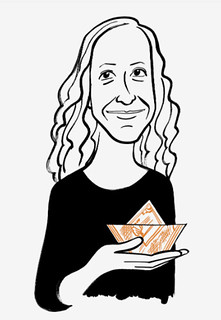 Carla Zaccagnini was seated on a bench the other day, riffling through a pile of cash.
Carla Zaccagnini was seated on a bench the other day, riffling through a pile of cash. I've been collecting money that's not in circulation anymore,
she said, looking up from stacks of bills sheathed in cellophane. So, currencies that are dead.
It was five days before Zaccagnini's first solo exhibition in the United States would open, at Amant, a nonprofit art space in Brooklyn, and three days before the U.S. Bureau of Labor Statistics would announce that consumer prices had risen 8.5 per cent in the past year, sparking panic about the cost of broccoli and gasoline. Zaccagnini's show, Cuentos de cuentas / Accounts of Accounting,
is based on her childhood in Argentina and Brazil in the nineteen-seventies and eighties, when hyperinflation drove people to hoard U.S. dollars. Zaccagnini recalled that grocery workers spent hours walking the aisles, replacing price tags throughout the day as prices went up.
In Brazil, for example, where annual inflation rates in the late eighties shot up above a thousand per cent, the currency declined so quickly that the government kept devaluing and renaming it. Before 1986, the Brazilian dollar was called the cruzeiro (a reference to the Southern Cross constellation); then it was renamed the cruzado (crusader
), and existing bills were stamped with a new value until fresh bills could be printed. In 1989, the currency was devalued again, and a thousand cruzados became one cruzado novo. And on and on. (A publication accompanying the exhibit estimates that one of today's Brazilian reals, as the currency is now called, would be worth 2,750,000,000,000,000,000 of the original reals used when Brazil became an independent country, in 1822.)
Each time there was a change, money in circulation had to be traded in for new bills, and the old ones were retired. A few years ago, Zaccagnini started buying them, on Mercado Libre, the Latin American eBay. The first idea I had was to just make a list, printed on the wall, of all the dead currencies since I was born,
she said. Currency is one of the identities of a country, like the national anthem. Can you imagine if we had a new anthem every three years?
She picked up a bluish-white bill worth five thousand cruzados, which featured a portrait of Candido Portinari, a famous Brazilian artist. Then I came up with the idea of little boats.
She folded the bill in half and pressed the corners down, before folding it again into quarters. It's the first thing you learn to do with paper,
she went on. It's something I kind of do when I'm bored and I have a paper in my hand. I make little boats.
After a few more folds, she stuck her fingers into the center and popped the sides out, revealing a trim vessel.
Ruth Estévez, Amant's chief curator, walked in. In addition to dozens of busted-currency boats, called Fleeting Fleet,
the exhibition was to include a six-foot-long mobile that, owing to an airport-worker strike in France, was stranded in Paris. Estévez had been calling FedEx for days, begging the company to turn the mobile over to a friend, who would bring it to New York. But it's in the warehouse there, and there is no way to take it out,
she said. It's like it's kidnapped.
To read the complete article, see:
Making Art Out of Inflation
(https://www.newyorker.com/magazine/2022/05/09/making-art-out-of-inflation)
LOOSE CHANGE: MAY 20, 2022
Here are some additional items in the media this week that may be of interest. -Editor
In the cut-out-the-middleman department, collectors in Washington, D.C. can visit the reopened coin store at the U.S. Mint headquarters. Hurry there and get your "swag bag". -Editor
The United States Mint is reopening its Washington, D.C. Coin Store on May 16, 2022. The store had been closed for more than two years to reduce the risk of Mint employee exposure to COVID-19.

Having customers coming back to the store is a great opportunity for the Mint to interact with the numismatic community,
said Matt Holben, Associate Director of Sales and Marketing. Listening to our customers' feedback, observing their reactions, and engaging in conversation with customers lead to better product development.
The store will offer a wide variety of United States Mint coins and medals for sale. The initial inventory will include limited quantities of some 2021 American Eagle gold and silver coin products.
The store will have sidewalk signage outside of the entrance letting customers know where to enter into the building.
The store is giving away swag bags
to the first 50 people who make a purchase.
To read the complete article, see:
United States Mint to Reopen Washington, DC Coin Store
(https://www.usmint.gov/news/press-releases/mint-to-reopen-washington-dc-coin-store)
F. Michael Fazzari published a short article about coin conservation in Numismatic News. Here's an excerpt - see the complete article online. Image: Developing corrosion spot on Jefferson nickel -Editor
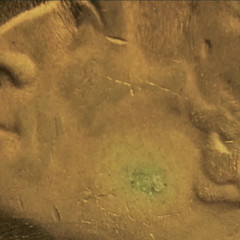 I joined the American Numismatic Association's Certification Service in Washington, D.C. While there, I was introduced to acetone. Very often, a coin sent in for authentication arrived with crud of some kind around its mintmark. In order to authenticate many of these coins, we had to call the submitter for permission to remove the crud. All it took was a few drops of acetone and a sliver of wood.
I joined the American Numismatic Association's Certification Service in Washington, D.C. While there, I was introduced to acetone. Very often, a coin sent in for authentication arrived with crud of some kind around its mintmark. In order to authenticate many of these coins, we had to call the submitter for permission to remove the crud. All it took was a few drops of acetone and a sliver of wood.
On one occasion, a customer sent in a 1936 proof cent for us to determine if it had a satin finish. The coin was bought in an auction described as having beautiful, sea-green toning. It was green, alright. The plastic flip was filled with liquid green PVC that also covered the coin. I conserved it with acetone, we authenticated it and sent it back. Only to be accused later of switching coins as the green color was no longer present. We bought the coin back but after that, the next batch of submission forums stipulated that by signing the forum we had permission to clean it if necessary to authenticate it!
To read the complete article, see:
Behind the Scenes: Coin Conservation
(https://www.numismaticnews.net/collecting-101/behind-the-scenes-coin-conservation)
A local television station published an update on the case of the senseless killing of Indianapolis coin dealer Paul Edmonds in 2020. -Editor
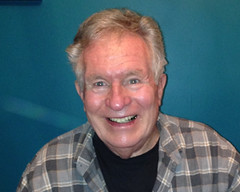 The woman accused in the deadly shooting of an Indianapolis coin dealer in 2020 was sentenced to 45 years in prison.
The woman accused in the deadly shooting of an Indianapolis coin dealer in 2020 was sentenced to 45 years in prison.
The shooting happened in September 2020 as the two sat in a car at a fast food restaurant parking lot, where a coin sale had been arranged.
Edmonds told an officer the woman didn't even get any of his money.
He later died at the hospital.
Edmonds owned Diamond Stamp and Coin for 35 years, operating his business from a display case in Shadeland Peddlers & Flea Market.
To read the complete article, see:
Woman sentenced in deadly shooting of Indianapolis coin dealer
(https://www.wthr.com/article/news/crime/woman-sentenced-in-deadly-shooting-of-indianapolis-coin-dealer-kayla-blankenship-paul-edmonds/531-448f5953-90da-4662-afe8-b5948c648db0)
FEATURED WEB SITE: RNUMIS
This week's Featured Web Site is the updated rNUMIS, an extensive numismatic digital library.
In 2012 rNumis was launched by Dr. Steve Moulding as a website that sold coin auction catalogs and fixed price lists, with a primary (but not exclusive) focus on Ancient Greece. We still do that (see LITERATURE FOR SALE in the main menu).
Behind the scenes - and over the past 9 years - we have been creating an extensive numismatic digital library. This library provides the material for our numismatic databases and these databases, in turn, provide the data for our numismatic research tools, some of which will be offered here. One of our main goals, for example, is an online resource for provenance research.
So while we will continue to sell physical catalogs that we no longer need, the website is being transitioned to the research site we always wanted. We still have an enormous amount of work to do, building the website and the research tools, and especially in populating the Greek Coins database, but we are excited to be moving in this direction and will report our progress here.
https://www.rnumis.com/
To read the earlier E-Sylum article, see:
MORE WEBSITES FOR RESEARCHING ANCIENTS
(https://www.coinbooks.org/v25/esylum_v25n01a10.html)

